
producer profile
27.06.2019
Domaine de la Pépière Producer Profile
<p><u><strong>2020 Update:</strong></u></p>
<p>It feels strange having to update profiles like Pépière’s. Almost like erasing the past, a past I was only tangentially part of! Joe and Denyse first visited Marc Ollivier in 1989. They likely began selling his 1988 in NYC shortly thereafter. Kevin McKenna, an equal partner at LDM since 1995, was their first customer for it when he was the buyer at Astor Wines! It was our first <glossary title="602">Loire</glossary> wine! I was three years old! We do, however, need to update you on a few things.</p>
<p>For starters, 2019 was Marc's last <span class="zalup"><span><glossary title="1109">vintage</glossary><span>.</span></span></span> He's officially retired. And while his house is just minutes from the <span class="zalup"><span><glossary title="254">cellar</glossary><span>,</span></span></span> he and Geneviève plan to spend the majority or their time in <glossary title="197">Brittany</glossary> enjoying the finer things in life (namely seafood). It's hard not to imagine Marc, who is REMARKABLY photogenic, as the face of the <glossary title="427">estate</glossary> anymore. He is so engrained in our history, a true peer and friend; erasing his name and face from Pépière will be impossible for many of us. At the end of the day, Pépière is his creation and his presence will always be felt. And if you need your Marc fix, you can always read his interview from 2012.</p>
<p>Today the <glossary title="427">estate</glossary> is in very capable hands with residing proprietors Rémi Branger and Gwénaëlle Croix. Rémi is a local that Marc has known since he was a kid. When his father retired in 2005, Marc purchased his land and Rémi started as an employee in 2006. Having long realized his daughters were not interested in inheriting the <span class="zalup"><span><glossary title="427">estate</glossary><span>,</span></span></span> Marc had him come on board as a partner in 2011.</p>
<p>Gwen, on the other hand, joined in a less straightforward fashion. After a decade working in the industrial sector, she moved to China with her family for her husband’s work. She discovered wine there and it quickly became a passion. Upon returning to France, she decided to switch careers and studied <glossary title="1103">viticulture</glossary> and <glossary title="422">oenology</glossary> at Montreuil Bellay. Her first visit to Pépière was a <glossary title="834">pruning</glossary> formation in early 2011. She instantly hit it off with Marc and Rémi (which to be fair is quite easy) and after finishing school, worked at the <glossary title="427">estate</glossary> a year before becoming a partner in 2014. </p>
<p>Marc will be the first to admit that adding new people and perspectives helped push Pépière forward. He largely credits Rémi as the impetus of finally <glossary title="332">converting</glossary> to <glossary title="746">organic</glossary> <span class="zalup"><span><glossary title="1103">viticulture</glossary><span>,</span></span></span> Gwen for <span class="zalup"><span><glossary title="160">biodynamics</glossary><span>.</span></span></span> Things in the <glossary title="254">cellar</glossary> have evolved as well, with more judicious applications of <glossary title="993">S02</glossary> and a fearlessness to push <em><glossary title="996">sur-lies</glossary></em> <glossary title="418">élevages</glossary> to new heights of three, four and even five years. Rémi and Gwen's enthusiasm and ambition have also expanded on Marc's legacy of <glossary title="959">single vineyard cuvées</glossary> with their development of the <glossary title="1152">cru</glossary> <glossary title="185">bottlings</glossary> for Clisson, Château-Thebaud, Monnières-Saint-Fiacre and Gorges. But let’s rewind a bit. </p>
<p>When Marc started Pépière with seven <span class="zalup"><span><glossary title="523">hectares</glossary><span>,</span></span></span> the <glossary title="1026">terroir</glossary> was unified and it made sense to produce only one wine. But as the <glossary title="427">estate</glossary> grew and the <glossary title="1026">terroirs</glossary> diversified, he began doing "what has always been done in the rest of France": he was already <glossary title="1104">vinifying</glossary> each <glossary title="760">parcel</glossary> separately, so it was intuitive to start <glossary title="185">bottling</glossary> <glossary title="959">single vineyard</glossary> <span class="zalup"><span><glossary title="363">cuvées</glossary><span>:</span></span></span> "Clos des Briords" in 1988, "Cormermais" in 1992... While this may seem totally normal to the average French oenophile, the <glossary title="697">Muscadet</glossary> works a bit differently. </p>
<p>Despite having some of the most varied <glossary title="1026">terroirs</glossary> and <glossary title="656">micro-climates</glossary> in all of France, the <glossary term="Muscadet" title="697">Muscadet</glossary> remains a region of scale and bulk dominated by large <glossary title="729">négociant</glossary> operations. One could optimistically opine that<font color="#7b143e"><b> its'</b></font> strength lies in blending all of its <glossary title="1026">terroir</glossary> into a more complex whole, but the blunt and far less charming truth is that most <glossary title="1089">vignerons</glossary> get paid (poorly) for grapes by the kilo irrespective of where they are grown because <glossary title="729">négociants</glossary> don't care. Even for independent <span class="zalup"><span><glossary title="427">estates</glossary><span>,</span></span></span> it is quite common to only produce a single <glossary title="363">cuvée</glossary> despite the obvious variations of soil and <glossary title="656">micro-climates</glossary> within their <glossary title="1133">plots. </glossary></p>
<p>Because the <glossary title="113">appellation</glossary> is heavily planted, grows only one grape and produces largely for immediate consumption, prices remain artificially low and do not encourage risk taking or breaking the mold. Despite being some of the cheapest <glossary title="1103">viticultural</glossary> land in all of France and home to living legends like Jo Landron, Michel Brégeon, Guy Bossard, Marc Pesnot, Luneau-Papin and of course Pépière itself, the environment remains poorly suited for small, ambitious <span class="zalup"><span><glossary title="1089">vignerons</glossary><span>.</span></span></span> A young kid could easily, for example, start a four <glossary title="523">hectare</glossary> <glossary title="427">estate</glossary> in <glossary title="105">Anjou</glossary> and find an immediate audience. In the <span class="zalup"><span><glossary title="697">Muscadet</glossary><span>,</span></span></span> they'd need at least double the surface, would still have to charge much more than the average local bottle and would find themselves fighting an uphill battle in a reticent, price driven market. It's a shame and also why you don't see a tremendous amount of new talent emerging like in other cheap areas such the aforementioned <span class="zalup"><span><glossary title="105">Anjou</glossary><span>,</span></span></span> <span class="zalup"><span><glossary title="1036">Touraine</glossary><span>,</span></span></span> <span class="zalup"><span> <glossary title="880">Roussillon</glossary><span>,</span></span></span> <glossary title="1205">Mâconnais</glossary> or the <span class="zalup"><span><glossary title="151">Beaujolais</glossary><span>.</span></span></span></p>
<p>So what does all this have to do with Pépière? Well, for the few <glossary title="427">estates</glossary> who have dedicated themselves to show the true potentials of <glossary title="697">Muscadet</glossary>'s <glossary title="1026">terroirs</glossary> (essentially the names mentioned in the above paragraph along with a few others), it's been a boon of opportunity. Over the last decade, there has been a push by the <glossary title="113">appellation</glossary> to create <glossary title="1152">cru</glossary> designations in hopes of bolstering <glossary title="697">Muscadet</glossary>'s reputation. Pépière was way ahead of the curve here, with half of the <glossary title="427">estate</glossary>'s 42 <glossary title="523">hectares</glossary> falling within the <glossary title="1152">crus</glossary> of Clisson, Monnières-Saint Fiacre, Château-Thébaud and Gorges. At the time this was simply Marc, Rémi and Gwen picking the most interesting vineyards. And to give perspective, the average independent <glossary title="697">Muscadet</glossary> <glossary title="427">estate</glossary> only has holdings of 15 to 20% within the <span class="zalup"><span><glossary title="1152">crus</glossary><span>.</span></span></span> </p>
<p>And while 50% of the <glossary title="427">estate</glossary>’s vineyards fall within the <glossary title="1152">cru</glossary> limits, <glossary title="1152">cru</glossary> wines only represent an average of 15% of Pépière's annual production. In some <glossary title="1109">vintages</glossary> they will produce less or no <glossary title="1152">cru</glossary> wines at all if the quality is not there. <glossary title="74">Aging</glossary> on the <glossary title="590">lees</glossary> is always longer than the mandated 17 months, lasting a minimum of two years. But Marc, Rémi and Gwen have not been afraid to push it to 36 or even 48 months in some cases. All grapes within the <glossary title="1152">crus</glossary> not deemed up to snuff (again, around 85%) go into the the entry level "La Pépie" <span class="zalup"><span><glossary title="363">cuvée</glossary><span>.</span></span></span> </p>
<p>What follows is a break down of all the <glossary title="363">cuvées</glossary> and their respective <span class="zalup"><span> <glossary title="1026">terroirs</glossary><span>:</span></span></span></p>
<p>"La Pépie" is a <glossary title="168">blend</glossary> of <glossary title="427">estate</glossary> fruit from all of Pépière's <span class="zalup"><span><glossary title="1026">terroirs</glossary><span>,</span></span></span> 50% of which fall within the <glossary title="1315">Muscadet Sèvre & Maine</glossary> <glossary title="113">appellation</glossary> and 50% within the <span class="zalup"><span><glossary title="1152">crus</glossary><span>.</span></span></span> Since 2016, the <glossary title="363">cuvée</glossary> is is supplemented with purchased fruit from neighboring <glossary title="760">parcels</glossary> with similar characteristics. This decision was not made lightly and results from a series of unsustainably low crops. </p>
<p>"Clos des Briords" is located on the hillsides of the <span class="zalup"><span><glossary title="620">river Maine</glossary><span>,</span></span></span> a <glossary title="1046">tributary</glossary> of the <span class="zalup"><span><glossary title="603">Loire</glossary><span>.</span></span></span> The site totals 4.40 <glossary title="523">hectares</glossary> and the vines were planted between 1950 and 1989, with the vast majority between 50 and 70 years old. The soils are "<glossary title="502">granite</glossary> de Thebaud" but do not fall within the Château-Thebaud <glossary title="1152">cru</glossary> designation (more on that <glossary title="1026">terroir</glossary> later). Only a small part of the oldest vines produce the "Clos des Briords" <span class="zalup"><span><glossary title="185">bottling</glossary><span>.</span></span></span></p>
<p>"Gras Moutons" is a <glossary title="594">lieu-dit</glossary> made up of two <glossary title="760">parcels</glossary> totaling 1.8 <glossary title="523">hectares</glossary> in the <glossary title="1152">cru</glossary> of Monnières-Saint Fiacre. The soils consist of <span class="zalup"><span><glossary title="909">sand</glossary><span>,</span></span></span> <glossary title="596">limestone</glossary> and <span class="zalup"><span><glossary title="496">gneiss</glossary><span>.</span></span></span> The constant winds in the area make for grapes that have to be <glossary title="521">harvested</glossary> later than the rest. While released young, this wine always benefits from a few years in bottle.</p>
<p>"Clisson" was originally called "Granite de Clisson" after the unique bedrock in the vineyard. Marc changed the name to "Clisson" to agree with the <glossary title="537">INAO</glossary> <glossary title="1152">cru</glossary> communal classification. Pépière owns 5.5 <glossary title="523">hectares</glossary> within the <glossary title="1152">cru</glossary> but only a part makes it to the actual "Clisson" <glossary title="185">bottling</glossary> (the rest goes into "La Pépie"<em>)</em>. It's a patchwork of vines of various ages planted on a unique mix of <span class="zalup"><span> <glossary title="504">gravel</glossary><span>,</span></span></span> <glossary title="301">clay</glossary><glossary title="301"> </glossary>and <glossary title="909">sand</glossary> on a <glossary title="991">subsoil</glossary> of <span class="zalup"><span><glossary title="502">granite</glossary><span>.</span></span></span> The oldest vines were planted in 1929 and on average the vines are 60 years old.</p>
<p>The <glossary title="427">estate</glossary> owns vines in the Gorges <glossary title="1152">cru</glossary> that used to belong to regarded grower Michel Brégeon. The plot is 1.67 <glossary title="523">hectares</glossary> and was planted in the late 1960's/early 1970's. Because it is so far from the <span class="zalup"><span><glossary title="427">estate</glossary><span>,</span></span></span> their colleague Fred Laillé works the vines <span class="zalup"><span><glossary title="746">organically</glossary><span>,</span></span></span> Pépière works his Clisson vines and they exchange <glossary title="520">hand-harvested</glossary> fruit. Gorges is the only area in the <glossary title="697">Muscadet</glossary> featuring <glossary title="145">basalt</glossary> soils. The wines have a unique structure compared to the others of the region.</p>
<p>Monnieres-St-Fiacre, planted in <glossary title="909">sandy</glossary> <glossary title="596">limestone</glossary> on <span class="zalup"><span><glossary title="496">gneiss</glossary><span>,</span></span></span> is the first officially designated <glossary title="1152">cru</glossary> in <span class="zalup"><span><glossary title="697">Muscadet</glossary><span>.</span></span></span> Prior to this being a <span class="zalup"><span><glossary title="1152">cru</glossary><span>,</span></span></span> Pépière would occasionally produce this wine as<em> "</em>Cuvée Eden" and/or it would go into "Gras Moutons". Pépière owns 3.35 <glossary title="523">hectares</glossary> within the <span class="zalup"><span><glossary title="1152">cru</glossary><span>.</span></span></span> The vines were planted in 1948, 1984 and 1991.</p>
<p>For Château-Thebaud, Pépière owns 14 <glossary title="523">hectares</glossary> within the <glossary title="1152">cru</glossary> but only the best grapes go into the "Château-Thebaud" <span class="zalup"><span><glossary title="185">bottling</glossary><span>,</span></span></span> with the vast majority going towards the production of "La Pépie". They work a plethora of <glossary title="1133">plots</glossary> of all ages and sizes, many as small as 20 <span class="zalup"><span><glossary title="1208">ares</glossary><span>.</span></span></span> The vines were planted between 1952 and 1997 with most vines planted between the late 1960's and early 1980’s. The “<glossary title="502">granite</glossary> de Château-Thebaud" here is fissured and permeable by the vine roots which have access to water during dry spells and absorb micro-nutrients along the way. Thébaud always needs longer <glossary title="74">aging</glossary> on the <glossary title="590">lees</glossary> than any of the other <glossary title="1152">cru</glossary> wines, for example 42 months in 2012.</p>
<p>In addition, a little over three <glossary title="523">hectares</glossary> of <span class="zalup"><span><glossary title="216">Carbernet Franc</glossary><span>,</span></span></span> <glossary title="366">Côt</glossary> and <glossary title="650">Merlot</glossary> are cultivated, planted by Marc so he could have some red to drink. As there is no red wine in the <glossary title="697">Muscadet</glossary> <span class="zalup"><span><glossary title="113">appellation</glossary><span>,</span></span></span> these are classified as <span class="zalup"><span><glossary title="1093">Vin de Pays</glossary><span>.</span></span></span> </p>
<p>Wow, the recap is done! And because I didn't feel like deleting it, here is Joe's original profile from who knows how long ago:</p>
<p>When Marc Ollivier is <em>on</em>, these are the top wines of the <glossary title="108">AOC</glossary> wines that are not only delicious young, but that can also age 10, 20 or 30 years.</p>
<p>Ollivier’s Muscadet-sur-Lie is the authentic item — it has <glossary title="590">lees</glossary> contact until the time of <span class="zalup"><span><glossary title="185">bottling</glossary><span>,</span></span></span> generally in late May. This extended contact gives it the crispness that makes <glossary title="697">Muscadet</glossary> so refreshing, and the classic wine match for seafood. It is the traditional way to make <span class="zalup"><span><glossary title="">Muscadet</glossary><span>,</span></span></span> but has become the exception as growers and shippers rush to bottle “technically correct” wines by early January.<br />
<br />
In this rush to bottle, <glossary title="697">Muscadet</glossary> producers use special <glossary title="321">“starter” yeasts</glossary> (which often also add flavors and aromas) to accelerate <glossary title="441">fermentation</glossary> and <glossary title="423">enzymes</glossary> or other techniques to finish the wine early. <glossary title="447">Sterile filtration</glossary> is in rampant use. <br />
<br />
Ollivier takes his time. He <glossary title="520">hand harvests</glossary> (also a rarity in the region), uses <span class="zalup"><span><glossary title="538">natural yeasts</glossary><span>,</span></span></span> waits for the wine to finish and bottles with a very light <span class="zalup"><span><glossary title="447">filtration</glossary><span>.</span></span></span> The vineyards are in <glossary title="740">old vines</glossary> (40 years and older) with a particularly good <glossary title="430">exposition</glossary> on a <glossary title="809">plateau</glossary> overlooking the river <span class="zalup"><span><glossary title="1004">Sèvre</glossary><span>.</span></span></span> All the vineyards are from original stock: Ollivier is the only grower in the <glossary title="697">Muscadet</glossary> who does not have a single <em><glossary title="304">clonal selection</glossary></em> in his vineyards. <br />
<br />
Ollivier also produces a very-old-vine <glossary title="363">cuvée</glossary> of <glossary title="697">Muscadet</glossary> from a single-plot vineyard in <span class="zalup"><span><glossary title="933">schist</glossary><span>,</span></span></span> the<strong> "</strong>Clos<em> </em>des Briords<strong><em>"</em></strong>. These are among the oldest vines in his <glossary title="427">estate</glossary> (they were planted in 1930) and they enjoy a particularly good <span class="zalup"><span><glossary title="430">exposition</glossary><span>.</span></span></span> Also, when most of his <glossary title="427">estate’s</glossary> vines are planted on poor, shallow soil with hard <glossary title="502">granite</glossary> very close to the surface, the<strong> </strong>Clos des Briords has a much deeper <glossary title="1032">top soil</glossary> of <glossary title="301">clay</glossary> and <glossary title="955">silica</glossary> over a brittle <glossary title="502">granite</glossary> <span class="zalup"><span><glossary title="991">subsoil</glossary><span>:</span></span></span> this ensures excellent drainage in wet years, and better moisture retention in dry summers. Ripening is slower, and the longer <glossary title="1163">hang-time</glossary> before <glossary title="521">harvest</glossary> allows for optimal <glossary title="639">maturity</glossary> to be reached.<br />
<br />
The <glossary title="1104">vinification</glossary> techniques are traditional for the area: no <glossary title="610">skin maceration</glossary><glossary title="610"> </glossary>but <glossary title="392">direct pressing</glossary> within two hours of picking, <glossary title="843">racking</glossary> of the <glossary title="700">must</glossary> after 12 hours to remove the solid matter, and <span class="zalup"><span><glossary title="1018">controlled temperatures</glossary><span>,</span></span></span> not to exceed 71.6 degrees F, for the <span class="zalup"><span><glossary title="441">fermentation</glossary><span>.</span></span></span> The <glossary title="74">aging</glossary> of the wine, on its <glossary title="590">lees</glossary> in <glossary title="986">stainless steel</glossary> <span class="zalup"><span><glossary title="1140">vats</glossary><span>,</span></span></span> lasts until <span class="zalup"><span><glossary title="185">bottling</glossary><span>,</span></span></span> about eight months later.</p>
<p>Because of the soil and greater <glossary title="324">concentration</glossary> achieved with <span class="zalup"><span><glossary title="740">old vines</glossary><span>,</span></span></span> the<strong> "</strong>Clos des Briords" is a more powerful wine that most <span class="zalup"><span><glossary title="697">Muscadets</glossary><span>.</span></span></span> It is very <glossary title="662">mineral</glossary> and quite austere in its youth, rather than fruity and light. Over a few months, or even years, if one can wait for it, it develops much complexity in <glossary title="120">aromatics</glossary> and <span class="zalup"><span><glossary title="990">structure</glossary><span>.</span></span></span> <br />
<br />
His latest <span class="zalup"><span><glossary title="363">cuvée</glossary><span>,</span></span></span> called "Eden", comes from a vineyard he acquired from his neighbor. The soil is <span class="zalup"><span> <glossary title="496">gneiss</glossary><span>.</span></span></span> The wine is lively with lovely floral notes. </p>
Article
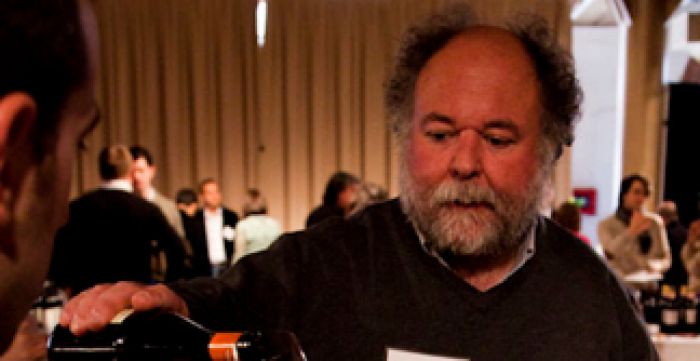
interview
27.06.2019
An Interview with Marc Ollivier from 2012
<p><em>This interview with Marc Ollivier took place at the <glossary title="904"><em>Salons des Vins de Loire</em></glossary> in February, 2012.</em></p>
<p><strong>Tell us about Domaine de la Pépière.</strong><br />
<br />
Domaine de la Pépière is 35 <span class="zalup"><span><glossary title="523">hectares</glossary><span>,</span></span></span> and is run by my partner Rémi Branger and I. 30 of those <glossary title="523">hectares</glossary> are in white, five in red. We are almost to the point of having the entire <glossary title="427">estate</glossary> <glossary title="332">converted</glossary> to <glossary title="746">organic</glossary> <glossary title="78">agriculture</glossary>; it's been a step by step process and currently the majority of our vines are worked this way. <br />
<br />
<strong>Working organically has been a long term goal for you. Can we talk about this?</strong><br />
<br />
There are of course many factors in this decision. I think that Rémi's arrival gave me more time to sit down and really think about how I could do it. It's also a much better time to work <glossary title="746">organically</glossary> from a technical standpoint. <br />
<br />
A huge inspiration has been through you guys, through meeting all the <glossary title="1089">vignerons</glossary> who were working <span class="zalup"><span><glossary title="746">organically</glossary><span>.</span></span></span> I tasted their wines and immediately felt there was something really interesting about them. I started exchanges with these guys, and through some great conversations I realized that <glossary title="332">converting</glossary> isn't as hard as most people think. <br />
<br />
<strong>Tell us your personal journey to becoming a vigneron.</strong><br />
<br />
My grandfather was a <span class="zalup"><span><glossary title="1089">vigneron</glossary><span>.</span></span></span> At the time is was just a few <span class="zalup"><span><glossary title="523">hectares</glossary><span>,</span></span></span> spread amongst other crops (tobacco) and livestock (cows). At first, my father and uncle continued my grandfather's exploitation. But when their children were born, things had to change because the farm's production wasn't enough to feed everybody. At that point, my father became an agricultural technician, while my uncle and cousins continued the farm work. <br />
<br />
I was going to university in <glossary title="707">Nantes</glossary> at the time, studying science. I realized very quickly that these studies could only lead to a job in education, and I had no desire to be a professor. I wanted to work outside, to be in contact with nature. I also wanted to stay in the <span class="zalup"><span><glossary title="697">Muscadet</glossary><span>,</span></span></span> so I thought: "Hey, why not <glossary title="1103">viticulture</glossary><em>?</em>" At the time I was not passionate about wine; it was just an idea. I found an <glossary title="422">oenological</glossary> program for adults in <glossary title="212">Burgundy</glossary> and I spent a year there. I was about 18 at the time, and I came back having found my true calling.<br />
<br />
<strong>Can we talk about the evolution from making only the base Pépière to now producing a large amount of cuvées?</strong><br />
<br />
When I first started, there were only seven <glossary title="523">hectares</glossary> of vines. Everything was in Pépière, so the <glossary title="1026">terroir</glossary> was unified. As the <glossary title="427">estate</glossary> grew and the <glossary title="1026">terroirs</glossary> diversified, I began doing what has always been done in the rest of France: I was already <glossary title="1104">vinifying</glossary> each <glossary title="760">parcel</glossary> separately, so it made perfect sense to make different <span class="zalup"><span><glossary title="363">cuvées</glossary><span>.</span></span></span> I started making<strong> "</strong>Clos des Briords" in 1988,<strong> "</strong>Clos Cormerais" in 1992, etc…<br />
<br />
<strong>And the reds? </strong><br />
<br />
I've always wanted to make reds. My original plan was to make red and <span class="zalup"><span><glossary title="694">moelleux wines</glossary><span>.</span></span></span> Evidently, the <glossary title="697">Muscadet</glossary> is not the best place to make <glossary title="694">moelleux</glossary>; we've tried but the results have been less that satisfactory. Reds, on the other hand, are perfectly adaptable to our <span class="zalup"><span><glossary title="1026">terroirs</glossary><span>.</span></span></span> I had a tiny <glossary title="760">parcel</glossary> at first. We then tore up and re-planted a <glossary title="760">parcel</glossary> at the bottom of a <span class="zalup"><span><glossary title="345">coteau</glossary><span>,</span></span></span> which was believed to have been used for vines a century earlier. We planted 2.5 <glossary title="523">hectares</glossary> there in the 90's, and have been planting new vines bit by bit since then. <br />
<br />
<strong>Have you always worked with native yeasts? </strong><br />
<br />
Not always. I used to <glossary title="1128">yeast</glossary> one or two <glossary title="1140">tanks</glossary> and let the rest <glossary title="441">ferment</glossary> naturally. I quickly noticed that the <glossary title="538">native yeast</glossary> wine was more interesting; the wines I made with <glossary title="321">selected yeasts</glossary> always had simpler, more primary aromas. I decided that working with <glossary title="538">native yeasts</glossary> would be an interesting way to make wine. It brought me back to the days when my grandfather made wine, and he never had any problem with his <span class="zalup"><span><glossary title="441">fermentations</glossary><span>.</span></span></span> <br />
<br />
I come from a generation where you were told you had to <glossary title="1128">yeast</glossary> or the wine wouldn't <span class="zalup"><span><glossary title="441">ferment</glossary><span>.</span></span></span> I was never convinced by this argument, because as we all know wine has been made without <glossary title="321">preselected yeasts</glossary> for millions of years. I knew it could be done in modern times. <br />
<br />
<strong>Let's talk about Rémi. How did you meet, and how did you end up partners?</strong><br />
<br />
Rémi was born a kilometer from my house. I've known him since he was a little kid. A few years ago I was looking for some vines, and I knew that Rémi's father was going to retire. I approached him and asked if he had a predecessor, and when he said no I told him I was interested. Rémi was finishing up his studies at the time, and with the acquisition of these new vines I was also looking to hire an employee. I can't remember if he asked me or if I asked him, but he started working for me immediately. This was in 2006, and I very quickly told him that if he was interested, he could have a place at Pépière. <br />
<br />
<strong>Let's talk about the Muscadet AOC, which has a bit of a bad rap (at least in France).</strong><br />
<br />
I have a theory on this, which is worth what it's worth... The <glossary title="697">Muscadet</glossary> has always been under the influence of <span class="zalup"><span><glossary title="729">négociants</glossary><span>.</span></span></span> This was originally a good thing, but the dynamic changed when the focus shifted to bulk sales, which require a simple, uniform product. Under this influence, a standardization of <glossary title="697">Muscadet</glossary> occurred. This phenomenon was perpetuated and spread by agricultural technicians, who used <span class="zalup"><span><glossary title="611">machine harvesting</glossary><span>,</span></span></span> <glossary title="321">preselected yeasts</glossary> and whatever technology available to make "clean" or "flawless" wines. This soon became the norm, and everyone was doing the exact same thing. <br />
<br />
<glossary title="697">Muscadet</glossary> stopped being interesting because it was made like a <span class="zalup"><span><glossary title="1093">Vin de Pays</glossary><span>.</span></span></span> What I mean by that is the wine's relation to <glossary title="1026">terroir</glossary> was completely abandoned. Technology was what mattered to people, not <span class="zalup"><span><glossary title="1026">terroir</glossary><span>.</span></span></span> Like any <glossary title="108">A.O.C</glossary> in France, if the vines are maintained and there is a real point of interest, you can make varied, interesting wines. <br />
<br />
Another big problem is that people started planting vines everywhere to create a larger supply of <span class="zalup"><span><glossary title="697">Muscadet</glossary><span>.</span></span></span> The obvious results are that the vines are in soils not suited for <span class="zalup"><span><glossary title="1103">viticulture</glossary><span>.</span></span></span> People forgot about <span class="zalup"><span><glossary title="1026">terroir</glossary><span>,</span></span></span> and by doing that they forgot what makes an <strong><glossary title="113">appellation</glossary></strong>: <span class="zalup"><span><glossary title="1089">vignerons</glossary><span>,</span></span></span> grapes and soils. <br />
<br />
<strong>Did your grandfather sell to a négociant? </strong><br />
<br />
My grandfather only worked three <span class="zalup"><span><glossary title="523">hectares</glossary><span>,</span></span></span> and sold a large part of his production in <glossary title="142">barrel</glossary> to cafés in <span class="zalup"><span><glossary title="707">Nantes</glossary><span>.</span></span></span> He would deliver them himself, <glossary title="142">barrel</glossary> by <span class="zalup"><span><glossary title="142">barrel</glossary><span>.</span></span></span> He also sold a bit to the <span class="zalup"><span><glossary title="729">négociant</glossary><span>.</span></span></span> In the 60's there was very little wine being <span class="zalup"><span><glossary title="185">bottled</glossary><span>.</span></span></span> <br />
<br />
<strong>How did you decide you wanted to bottle independently?</strong> <br />
<br />
After my formation, I worked at my uncle's for two years. When Pépière became available, I knew I wanted to take over and I knew I wanted to <glossary title="185">bottle</glossary> independently. At the time, you made a good living selling to the <span class="zalup"><span><glossary title="729">négociant</glossary><span>,</span></span></span> but <glossary title="185">bottling</glossary> independently felt like the only way to meet the actual people who drank the wine. I never envisioned it any other way. <br />
<br />
<strong>Did you always want to work in Muscadet?</strong><br />
<br />
When I went to school in <span class="zalup"><span><glossary title="707">Nantes</glossary><span>,</span></span></span> it was so I'd be close to home. I didn't know it would be <glossary title="1103">viticulture</glossary> at the time, but I did know that whatever my job ended up being, I would do it here. That's why I have a tough time traveling. Your father had to really twist my arm to come to the U.S. I refused for years! <br />
<br />
What can I say? I'm a <span class="zalup"><span><glossary title="769">peasant</glossary><span>,</span></span></span> I've very much linked to soil and to nature. I have a hard time being anywhere else.<br />
<br />
<strong>Let's talk about "natural wine". Where do you stand?</strong><br />
<br />
Rémi and I have never claimed to be part of the <glossary title="708">natural wine</glossary> family. I've always been very interested by these wines, and do envision my wines to have the same qualities. But we've always used <span class="zalup"><span><glossary title="993">SO2</glossary><span>,</span></span></span> and we don't plan on eliminating it. At the same time, I know the term "natural" is imprecise, and that many would consider me a "<glossary title="708">natural</glossary>" winemaker even if we use a little <span class="zalup"><span><glossary title="993">sulfur</glossary><span>.</span></span></span> <br />
<br />
There is a technical reason we use <span class="zalup"><span><glossary title="993">S02</glossary><span>.</span></span></span> Pépière is all about <span class="zalup"><span> <glossary title="662">minerality</glossary><span>,</span></span></span> purity and freshness. We don't want any <span class="zalup"><span> <glossary title="622">malolactic fermentation</glossary><span>,</span></span></span> so after <glossary title="87">alcoholic fermentation</glossary> we <glossary title="843">rack</glossary> the wine to a cold, <glossary title="1018">temperature controlled </glossary><glossary title="1140">tank</glossary> and slightly <glossary title="993">sulfur</glossary> it in December and January (on average 5g total). We almost never <glossary title="993">sulfur</glossary> at <span class="zalup"><span><glossary title="185">bottling</glossary><span>.</span></span></span> <br />
<br />
I don't care how people categorize me within this debate, but I must say that when I drink <glossary title="913">sans souffre</glossary> wines, I notice that you really taste the grape and the <span class="zalup"><span><glossary title="1026">terroir</glossary><span>.</span></span></span> I've also realized that you can make <glossary title="993">sulfur</glossary> free wine and it can still age. So progressively, we have tremendously reduced the amount of <glossary title="993">sulfur</glossary> in the wine over the years. <br />
<br />
<strong>What do you like to drink?</strong><br />
<br />
A lot of things. I love <glossary title="602">Loire</glossary> wine, and they represent about 50% of the wines I drink. I still love <span class="zalup"><span><glossary title="694">Moelleux</glossary><span>,</span></span></span> and regret the <glossary title="105">Anjou</glossary> and <glossary title="684">Montlouis</glossary> guys make less of it because it's hard to sell. I like the <glossary title="372">Rhône</glossary> and the South a lot.</p>
Article
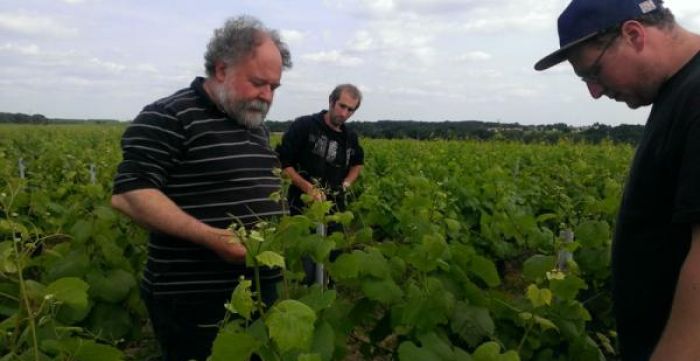
producer visit
22.07.2019
This visit to Domaine de la Pépière took place in June, 2013
<p><strong><em>This visit at Domaine de la Pépière took place in June, 2013.</em></strong></p>
<p><strong><em>Words by Jules Dressner, photos by John Kafarski and Jules Dressner.</em></strong></p>
<p>You'd think that by this point, we'd have run out of things to say about Domaine de la Pépière. WRONG! <br />
<br />
We started the visit by driving to the <glossary title="594">lieu-dit</glossary> of Gras Mouton<em>s</em>, a <glossary title="1026">terroir</glossary> Marc started <glossary title="1104">vinifying</glossary> in 2007. </p>
<p><img src="http://louisdressner.com/uploads/images/article/2019_Jul_22//c8/f0/c8f0086cb672448bfe348d439d38235c.jpg" /><br />
<br />
Soil wise, Gras Moutons distinguishes itself by being very <glossary title="301">clay</glossary> heavy and rocky.</p>
<p><img src="http://louisdressner.com/uploads/images/article/2019_Jul_22//fc/b4/fcb47c312f834cb97dfcaa330ab291d6.jpg" /></p>
<p><img src="http://louisdressner.com/uploads/images/article/2019_Jul_22//80/97/8097f6f899c189478c9f0ce1fb9b1e20.jpg" /></p>
<p><img src="http://louisdressner.com/uploads/images/article/2019_Jul_22//b1/f3/b1f3301c294c1cbfd9b21f610377b93b.jpg" /><br />
<br />
The <glossary title="656">microclimate</glossary> is also unique, characterized by its constant winds.<br />
<br />
<em>"This helps aerate the vines, and keeps them clean of illness." </em><br />
<br />
Sadly, the constant winds also mean that shitty <glossary title="279">chemicals</glossary> being used by neighbors occasionally float over to the Pépière vines. Here's a leaf suffering from <glossary title="526">herbicide</glossary> burn:</p>
<p><img src="http://louisdressner.com/uploads/images/article/2019_Jul_22//db/01/db011c50ddb240fc488f124a53a21dca.jpg" /><br />
<br />
Not cool.<br />
<br />
The Gras Moutons vines are spread over two <glossary title="760">parcels</glossary> for a total of 1.7 <span class="zalup"><span><glossary title="523">hectares</glossary><span>.</span></span></span> They are 15, 40 and 65 years old. Rémi's father grandfather owned nine <glossary title="523">hectares</glossary> of these at one point. <br />
<br />
Here's a picture of a weird bug I'd never seen before. </p>
<p><img src="http://louisdressner.com/uploads/images/article/2019_Jul_22//81/83/8183946d11917d33a3789a65b908154e.jpg" /><br />
<br />
After hopping back into the <a href="http://www.youtube.com/watch?v=sBe3QzVW5_8" target="_blank">Marc Mobile</a>, we drove over to Pépière's newest<strong> <glossary title="1152">cru</glossary></strong>,<strong> </strong>Château-Thébaud.</p>
<p><img src="http://louisdressner.com/uploads/images/article/2019_Jul_22//be/aa/beaa60c7bb7274622755f358b9ffa9ea.jpg" /><br />
<br />
The soils here are rich <glossary title="502">granite</glossary> and <span class="zalup"><span><glossary title="909">sand</glossary><span>.</span></span></span> </p>
<p><img src="http://louisdressner.com/uploads/images/article/2019_Jul_22//ec/b7/ecb7630a3c4667fccd8df4b8a769af88.jpg" /><br />
<br />
1.5 <strong><glossary title="523">hectares</glossary></strong> are spread over two <span class="zalup"><span><glossary title="760">parcels</glossary><span>.</span></span></span> The first is planted in extremely vigorous young vines, so much so that in some <glossary title="1109">vintages</glossary> Marc and Rémi feel obligated to <glossary title="507">green harvest</glossary> in order to lower <span class="zalup"><span><glossary title="1129">yields</glossary><span>.</span></span></span> <glossary title="646">Melon de Bourgogne</glossary> vines tend to produce very high <glossary title="1129">yields</glossary> even without <glossary title="279">chemical</glossary> <span class="zalup"><span><glossary title="442">fertilizers</glossary><span>,</span></span></span> and to assure optimal <span class="zalup"><span><glossary title="324">concentrations</glossary><span>,</span></span></span> the Pépière crew intentionally keeps things at a very low 35 to 4 <span class="zalup"><span>0<glossary term="hl/ha" title="528">hl/ha</glossary><span>.</span></span></span><br />
<br />
The lower <span class="zalup"><span><glossary title="1129">yielding</glossary><span>,</span></span></span> older vines are over 60 years old. </p>
<p><img src="http://louisdressner.com/uploads/images/article/2019_Jul_22//f1/29/f1299550e76787f0673f54192f37ec5e.jpg" /></p>
<p><img src="http://louisdressner.com/uploads/images/article/2019_Jul_22//10/06/10060e0c71a99e77fae6984ab2f97ad9.jpg" /><br />
<br />
Marc and Rémi love working here because the <glossary title="430">exposition</glossary> is more South, and the "hotter soils" means more advanced, homogeneous <glossary title="1179">flowering</glossary> and <span class="zalup"><span><glossary title="639">maturing</glossary><span>.</span></span></span> <br />
<br />
Our final and longest vineyard visit was a long stroll through the Pépière vineyard, the 10 <glossary title="523">hectare</glossary> <glossary title="305">clos</glossary> that produce the base "Pépière" and "Clos des Briords <span class="zalup"><span><glossary title="363">cuvées</glossary><span>.</span></span></span><br />
<img src="http://louisdressner.com/uploads/images/article/2019_Jul_22//52/c9/52c966c54749b10afad2a2a36feee315.jpg" /><br />
<br />
The soils here are composed of super-light, <glossary title="909">sandy</glossary> <span class="zalup"><span><glossary title="502">granite</glossary><span>.</span></span></span> <br />
<br />
<img src="http://louisdressner.com/uploads/images/article/2019_Jul_22//f6/f5/f6f55c86d21f4ba6fa09fd28bdc89fa2.jpg" /><br />
<br />
Upon further inspection, Marc pointed out the slender, silver <glossary title="655">mica-schist</glossary><glossary title="655"> </glossary>chunks that can be spotted all over the vineyard. <br />
<br />
<img src="http://louisdressner.com/uploads/images/article/2019_Jul_22//63/0d/630dc950b7d136b0421848d5137f8c5d.jpg" /><br />
<br />
While they don't add anything to the soil's complexity, Marc theorizes that their constant reflection of the sun affects grape <span class="zalup"><span><glossary title="639">maturities</glossary><span>.</span></span></span> Upon even the slightest bit of friction, these flake into paper-thin morsels. <br />
<br />
In the late 90's, Marc decided to plant some reds here. At the time, he used what was available to him and planted, amongst others, <glossary title="366">Côt</glossary> from <span class="zalup"><span><glossary title="304">clonal selections</glossary><span>.</span></span></span> Years later, he was able to acquire some <glossary title="941">massales</glossary> from Clos Roche Blanche's 100+ year old vines. The difference in vigor and quality has amused Marc for a long time, so he decided to give us a side by side comparison.</p>
<p><img src="http://louisdressner.com/uploads/images/article/2019_Jul_22//ec/5d/ec5d159d5873bb8fc2b00180f042f6b9.jpg" /><br />
<br />
The <glossary title="941">massale</glossary> is the one on the right: a third less vigorous, but two thirds more <span class="zalup"><span><glossary title="324">concentrated</glossary><span>.</span></span></span> If it hasn't already been made clear, Marc is a fan of quality over quantity. <br />
<br />
We also saw the oldest vines on the <span class="zalup"><span><glossary title="427">estate</glossary><span>,</span></span></span> which are over 100 years old. </p>
<p><img src="http://louisdressner.com/uploads/images/article/2019_Jul_22//7b/91/7b914f916fe86efdf0f54fd38e8d25d8.jpg" /><br />
<img src="http://louisdressner.com/uploads/images/article/2019_Jul_22//2a/84/2a84275479fd9a91ac9e75f689549596.jpg" /></p>
<p>Marc says these are productive as ever.</p>
Article
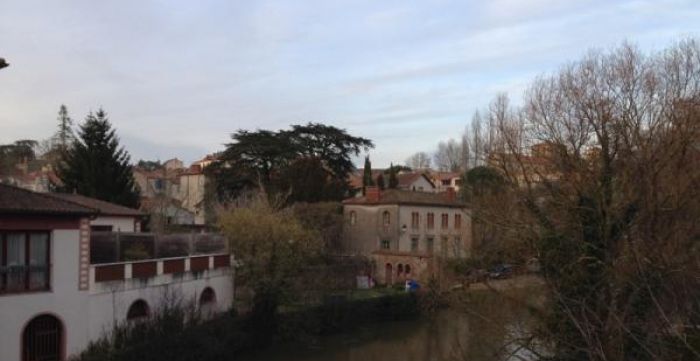
producer visit
22.07.2019
This visit to Domaine de la Pépière took place in February, 2013
<p><strong><em>This visit to<font color="#7b143e"> Domaine</font></em></strong><strong><em> de la Pépière took place in February, 2013.</em></strong></p>
<p><strong><em>Words by Jules Dressner, photos by Susie Curnutte and Bonnie Crocker.</em></strong></p>
<p>After a flight from JFK to Amsterdam, a quick connection got us into <span class="zalup"><span><glossary title="707">Nantes</glossary><span>.</span></span></span> We grabbed our luggage, hopped into our official LDM tour vehicles (sponsored by Jean Paul Brun's <em>Drink </em><glossary title="151"><em>Beaujolais</em></glossary><em>!</em> ad campaign) and drove to our first destination, the beautiful, peaceful town of <span class="zalup"><span><glossary title="303">Clisson</glossary><span>.</span></span></span> </p>
<p><img src="http://louisdressner.com/uploads/images/article/2019_Jul_22//bc/c3/bcc3f3a0bb91d35cb616b149f4c53250.jpg" /></p>
<p><img src="http://louisdressner.com/uploads/images/article/2019_Jul_22//d2/a3/d2a33b53200210bc4eee634e806e28c7.jpg" /></p>
<p><img src="http://louisdressner.com/uploads/images/article/2019_Jul_22//c0/35/c0350f29fe4d06767a611d15a372c404.jpg" /><br />
<br />
This sleepy town of 6,000 is split by the <span class="zalup"><span><glossary title="1004">Sèvre river</glossary><span>.</span></span></span> Every summer, 115 000 people invade it to celebrate... <br />
<br />
HELL FEST!!!!!!!!!!!!!!!!!!!!!!!!!!!!!!!!!!!!!!!!!!!!!!!!!!!!!!!!!!!!!!!!!!!!!!!!!!!!!!!!!!!!!!!!!!!!!!!!!!!!!!!</p>
<p><iframe allowfullscreen="" frameborder="0" height="360" src="//www.youtube.com/embed/Ht1GL8ndFeI" width="640"></iframe><br />
<br />
Kiss, ZZ Top, Def Leppard and many others are headlining this year. The pizzeria we ate at had <a href="http://www.youtube.com/watch?v=5qguRSgzs80" target="_blank">Twisted Sister</a> poster autographed by the whole band, and I can't tell you how much of an honor it was eating in the same place as Dee Scheider.<br />
<br />
Our first night in town, Marc and Geneviève Ollivier joined us at <em>La Bonne Auberge</em>, which was in many's top three meals of the trip. The restaurant is adorned with beautiful cat art. </p>
<p><img src="http://louisdressner.com/uploads/images/article/2019_Jul_22//ca/69/ca69664bdc68f7a49cccb5f773ddbf68.jpg" /><br />
<br />
The following morning, we drove to Pépière for the 16th annual <span class="zalup"><span><glossary title="697">Muscadet</glossary><span>-</span></span></span>a-thon™, aka the culmination of all that is good in this world. Look at Marc's beautfiful house!</p>
<p><img src="http://louisdressner.com/uploads/images/article/2019_Jul_22//0f/ec/0fecd88f632e281886e76aaef9122508.jpg" /></p>
<p><img src="http://louisdressner.com/uploads/images/article/2019_Jul_22//16/a6/16a6f7bea0c9a3b4bbfac0d3b85b2a39.jpg" /></p>
<p><img src="http://louisdressner.com/uploads/images/article/2019_Jul_22//d3/9f/d39f9d1bbdf9d5c865e617b7d306b65a.jpg" /><br />
<br />
After being greeted by Marc and Rémi, we were introduced to the newest member of the Pépière team, Gwénaëlle!</p>
<p><img src="http://louisdressner.com/uploads/images/article/2019_Jul_22//93/bd/93bd17e25233731ce1a3ce11bcd67b09.jpg" /><br />
<br />
Gwen just started in January, and is full of enthusiasm to be working at the <span class="zalup"><span><glossary title="427">estate</glossary><span>.</span></span></span> After our introduction, we do what we always do at <span class="zalup"><span><glossary title="697">Muscadet</glossary><span>-</span></span></span>a-thon™, which is head to the <glossary title="254">cellar</glossary> to taste upcoming <span class="zalup"><span><glossary title="1109">vintages</glossary><span>.</span></span></span></p>
<p><img src="http://louisdressner.com/uploads/images/article/2019_Jul_22//11/55/1155cadf754abcda0c6a824a2f5bdb6c.jpg" /><br />
<br />
If you've been reading these visit recaps regularly, you know what I'm about to say. Everything was great, the wines are delicious, buy them blah blah blah... One point of conversation that was particularly interesting, however, was about the new <glossary title="697">Muscadet</glossary> <glossary title="108">A.O.C</glossary>'s going into effect over the next few years. <span class="zalup"><span><glossary title="303">Clisson</glossary><span>,</span></span></span> Gorges and <glossary title="588">Le Pallet</glossary> now exist as<font color="#7b143e"><strong> <glossary term="Cru" title="1152">crus</glossary></strong></font> since the 2011 <span class="zalup"><span><glossary title="1109">vintage</glossary><span>,</span></span></span> and four more will take effect in the next two years. Marc truly believes will change the perception of <glossary title="697">Muscadet</glossary> for French wine drinkers, who for the most part associate the region with cheap, standardized and mass produced supermarket wine. <br />
<br />
We then set off to the vines, starting with the site that produces the "Clisson"<font color="#7b143e"><strong> </strong></font><span class="zalup"><span><glossary title="363">cuvée</glossary><span>.</span></span></span></p>
<p><img src="http://louisdressner.com/uploads/images/article/2019_Jul_22//7e/1c/7e1ccb4f9ce60db9177e2ec3b0acba1c.jpg" /></p>
<p><img src="http://louisdressner.com/uploads/images/article/2019_Jul_22//b1/ce/b1cead4ae14d3aba14ff64d66c5b46d3.jpg" /></p>
<p><img src="http://louisdressner.com/uploads/images/article/2019_Jul_22//9b/0e/9b0e6278fcfba316794c9bc86ea5a7d5.jpg" /><br />
<br />
This year, Marc decided to switch things up and give us a lesson on how to prune!</p>
<p><img src="http://louisdressner.com/uploads/images/article/2019_Jul_22//0c/92/0c92a717976ca6e88d2d16e5dbbf6c8f.jpg" /></p>
<p><img src="http://louisdressner.com/uploads/images/article/2019_Jul_22//28/88/288899d3998a0e62737c774e05665775.jpg" /><br />
<br />
Without getting overly technical, the process involves selecting one of the many <glossary title="232">canes</glossary> that will produce the grapes in the coming <span class="zalup"><span><glossary title="1109">vintage</glossary><span>,</span></span></span> as well as prepping one for the next <span class="zalup"><span><glossary title="1109">vintage</glossary><span>.</span></span></span> A pruned vine looks like this:</p>
<p><img src="http://louisdressner.com/uploads/images/article/2019_Jul_22//1c/18/1c18bc88124ee5868aa321a4034beab1.jpg" /><br />
<br />
So to reiterate, that <glossary title="232">cane</glossary> tied down to the left will produce 2013 fruit, and the little guy you can spot towards the middle of the foot will be for 2014. Marc does this so quickly and instinctively that you would never guess he was making educated decisions affecting the next two years of his production. <br />
<br />
After Marc's demonstration, the brave Nicholas Montigelli from Avant Partir gave it a shot. </p>
<p><img src="http://louisdressner.com/uploads/images/article/2019_Jul_22//02/0e/020ec20e7334f26e55e18b199c401aca.jpg" /><br />
<br />
Josefa also had a go at it. Let's just say they both need a little more practice. <br />
<br />
Next up, we checked out the Clos des Briords <span class="zalup"><span><glossary term="Parcel" title="760">parcel</glossary><span>.</span></span></span> It was muddy!</p>
<p><img src="http://louisdressner.com/uploads/images/article/2019_Jul_22//8d/63/8d63489e5d0b098535a4a1e2ed0055b7.jpg" /></p>
<p><img src="http://louisdressner.com/uploads/images/article/2019_Jul_22//c4/04/c4041f2eae9bd318dfcc8ad6306e5118.jpg" /><br />
<br />
Here Marc talked about his <glossary title="1103">viticultural</glossary> practices, <a href="http://louisdressner.com/date/2012/02/16/92/?as=muscadet" target="notSet">which I wrote about in detail last year</a>. </p>
<p>After the vines, it was time to EAT OYSTERS AND HOMEMADE PÂTÉ AND DRINK BACK <glossary title="1109">VINTAGES</glossary> OF PÉPIÈRE GOING BACK TO 1983!</p>
<p><img src="http://louisdressner.com/uploads/images/article/2019_Jul_22//db/98/db983b0deca14df710ed8a6c1302dbff.jpg" /></p>
<p><img src="http://louisdressner.com/uploads/images/article/2019_Jul_22//86/d0/86d0ff79c9f4c8b3072511c493745cf1.jpg" /><br />
<br />
The woodcock and fois gras pâté was my favorite, with the wild boar a close second. Big news: this was the first wild board pâté Marc made with a boar he hunted himself! Not only does this continue the being served wild board on trips trend, but it inspired me to coin the term <em>"slayed and made"</em>. Don't be surprised when that catches on. <br />
<br />
Also, Geneviève is the best because she always makes sure there is an abundance of vegetables to eat.</p>
<p><img src="http://louisdressner.com/uploads/images/article/2019_Jul_22//c3/8a/c38abb2b37dc4be6bd7e5bab94240438.jpg" /><br />
<br />
Seriously, those were the only vegetables we ate the whole trip. Unless rilettes are technically considered a vegetable in France, but I'm pretty sure even they acknowledge that it's meat slow-cooked in its own fat.</p>
Article
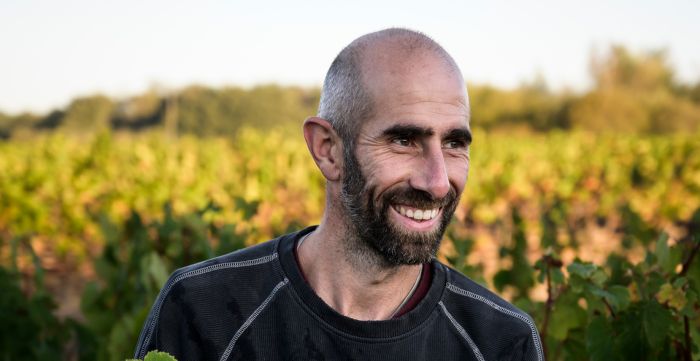
harvest report
03.01.2023
2023 Harvest Report from Gwénaëlle Croix
<p><strong>September 26th, 2023:</strong></p>
<p>We are almost done with the <span class="zalup"><span><glossary term="Harvest" title="521">harvest</glossary><span>,</span></span></span> and just have a bit of <glossary term="Malbec" title="366">Côt</glossary> and <glossary term="Cabernet Franc" title="216">Cabernet</glossary> to pick in the coming weeks. We take this reprieve to write to you about the last three weeks in the vines. </p>
<p>We started on Monday, September 4th with a team of 70 pickers under a radiant sun that had us all VERY HOT. This trend persisted through the first week of <span class="zalup"><span><glossary term="Harvest" title="521">harvest</glossary><span>.</span></span></span> On our second day, the 5th, we decided to start an hour earlier to take advantage of the cooler weather. This gave the pickers something unexpected: seeing the sun rise in the vines! On the third day of <span class="zalup"><span><glossary term="Harvest" title="521">harvest</glossary><span>,</span></span></span> we picked the grapes for the Briords <glossary term="Cuvée" title="363">cuvée</glossary> (which came in at an <glossary term="alcoholic potential" title="1381">alcoholic potential</glossary> of 11.95%) and threw out <glossary term="Cluster/Bunch" title="1138">bunches</glossary> that were in poor shape, likely due to the rains we experienced in late August. The following day we focused on <glossary term="Parcel" title="760">parcels</glossary> from Château Thébaud destined for a <glossary term="Cru" title="1152">cru</glossary> <span class="zalup"><span><glossary term="Bottling" title="185">bottling</glossary><span>.</span></span></span> Friday, which was the hottest day yet, we picked the grapes for a new <glossary term="Single Vineyard Bottling" title="959">single-parcel</glossary> <glossary term="Cuvée" title="363">cuvée</glossary> on <glossary term="Terroir" title="1026">terroirs</glossary> of pure gabbro, grapes we purchased but <glossary term="Harvest" title="521">harvested</glossary> ourselves.</p>
<p>After this exhausting, very hot week, the <glossary term="Harvest" title="521">harvest</glossary> team got a well deserved weekend of rest after all their hard work. No time for rest in the <glossary term="Cellar" title="254">cellar</glossary> though, where we were very busy: the first <glossary term="Vat/Tank" title="1140">vats</glossary> had started to <span class="zalup"><span><glossary term="Fermentation" title="441">ferment</glossary><span>,</span></span></span> imparting that specific, singular odor we only experience once a year. </p>
<p>The second week of picking was much more tolerable. The sun was still out but the heat was less suffocating. After focusing on many <glossary term="Parcel" title="760">parcels</glossary> destined for "La Pepie", on September 12th we picked the grapes that will produce "Gras Moutons". Similar to our first week in the vines, globally the <glossary term="Harvest" title="521">harvest</glossary> is quite beautiful, though there are little patches where we needed to sort and throw out some <span class="zalup"><span><glossary term="Cluster/Bunch" title="1138">bunches</glossary><span>.</span></span></span> In total, I'd estimate a 5% to 7% loss in total volume. But the <glossary term="Cluster/Bunch" title="1138">bunches</glossary> we did pick were magnificent, nothing like 2022 where some had really suffered from the heat. In fact they were so generous that it wasn't uncommon to spot pickers taking big bites from them to keep cool. We picked the grapes for the Monnières Saint Fiacre <glossary term="Cru" title="1152">cru</glossary> on Wednesday, September 13th.</p>
<p>On Thursday the 14th, we'd pick the white grapes with the highest <span class="zalup"><span><glossary term="alcoholic potential" title="1381">alcoholic potential</glossary><span>,</span></span></span> around 13.5% for the Clisson. On Monday the 18th, we were forced to pause for about an hour due to an episode of rain. And finally, on Wednesday the 19th, we finished up with the most late-ripening <glossary term="Parcel" title="760">parcels</glossary> for "La Pépie" and some others for <glossary term="Cuvée" title="363">cuvées</glossary> we'll be able to talk more about in the near future. Right as we were getting ready to throw our big party to celebrate the 2023 <span class="zalup"><span><glossary term="Harvest" title="521">harvest</glossary><span>,</span></span></span> the torrential rain we kept hearing and worrying about finally erupted from the sky. It was a very close call, and we were happy to hear the 40mm of rain furiously resonating on the roof of our <glossary term="Cellar" title="254">cellar</glossary> with all the juices safe inside. </p>
Article
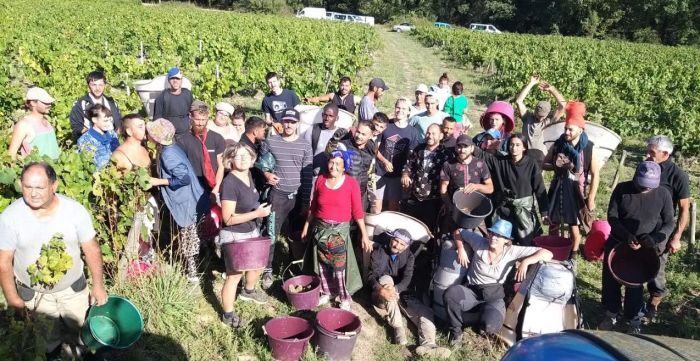
harvest report
21.12.2022
2022 Domaine de la Pépière Harvest Report
<p><strong>September 22nd, 2022.</strong></p>
<p>We finished picking all of the white grapes on Monday, September 12th after 15 days of <span class="zalup"><span><glossary term="Harvest" title="521">harvesting</glossary><span>.</span></span></span> Since then we've taken in some of the reds: <glossary term="Merlot" title="650">Merlot</glossary> and a bit of <span class="zalup"><span><glossary term="Malbec" title="366">Côt</glossary><span>.</span></span></span> We are enjoying this nice summer weather to let the <glossary term="Cabernet Franc" title="216">Cabernet Franc</glossary> continue to <span class="zalup"><span><glossary term="Maturation" title="639">mature</glossary><span>,</span></span></span> and estimate picking it on September 27th. This year reminds us of a saying from our local "ancient" generation: "as long as it's not all in the cellar, it's hard to know what you actually <span class="zalup"><span><glossary term="Harvest" title="521">harvested</glossary><span>.</span></span></span>"</p>
<p>Here's a quick recap of the season: after four nights of <glossary term="Frost" title="1135">frost</glossary> in April 2022, we were lucky to have a very beautiful and long period of sun and dryness. These conditions permitted us to conserve small <glossary term="Cluster/Bunch" title="1138">bunches</glossary> that, under normal circumstances (colder weather and humidity) would have shriveled up.</p>
<p>The extremely hot and dry summer had us worried: the berries, under constant stress, seemed so small... On August 15th we finally got salvation through 35mm of rain, kicking the vegetative cycle back in motion and plumping up the grapes a bit. </p>
<p>We started <glossary term="Harvest" title="521">harvesting</glossary> on August 24th. This date is identical to 2020, both the earliest we've ever started <span class="zalup"><span><glossary term="Harvest" title="521">harvest</glossary><span>.</span></span></span> On the 25th we picked the Briords <span class="zalup"><span><glossary term="Parcel" title="760">parcel</glossary><span>,</span></span></span> then the vines for the "La Pepie" <span class="zalup"><span><glossary term="Cuvée" title="363">cuvée</glossary><span>.</span></span></span> On Saturday and Monday our team picked in the <glossary term="Cru" title="1152">cru</glossary> of Chateau Thébaud, and here you could really see the effects of the August rain. While <span class="zalup"><span><glossary term="Harvest" title="521">harvesting</glossary><span>,</span></span></span> the <glossary term="alcoholic potential" title="1381">potential</glossary> went from 11% to 12% in Thébaud. However the summer stress affected <span class="zalup"><span><glossary term="Acidity" title="71">acidity</glossary><span>,</span></span></span> which will be lower than in past <span class="zalup"><span><glossary term="Vintage" title="1109">vintages</glossary><span>.</span></span></span> </p>
<p>While still <glossary term="Harvest" title="521">harvesting</glossary> the various <glossary term="Terroir" title="1026">terroirs</glossary> for the "La Pepie" <span class="zalup"><span><glossary term="Cuvée" title="363">cuvée</glossary><span>,</span></span></span> we picked Gras Mouton on August 31st, Monières Saint Fiacre on September 9th and Clisson on Monday, September 5th. As is always the case, it's the juices from Clisson that have the highest concentration of sugar, with an extra half degree of <span class="zalup"><span><glossary term="alcoholic potential" title="1381">potential alcohol</glossary><span>,</span></span></span> between 12.5% and 13%. We got a little bit of rain on September 9th: the freshness was welcomed by our harvest team who had been picking on very hot days. </p>
Article
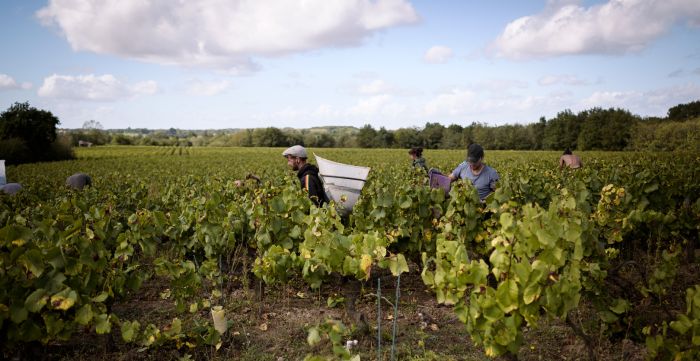
harvest report
16.12.2021
2021 Harvest Report from team Pépière
<p><strong>(NOTE: while not mentioned, Pépière lost 75% of it's crop to frost and mildew in 2021). </strong></p>
<p><strong>October 8th, 2021.</strong></p>
<p>With a reduced team of 38 pickers, we started the 2021 <glossary term="Harvest" title="521">harvest</glossary> on Thursday, September 16th on a bright and sunny day. The first thing we picked were the grapes in the two <glossary term="Parcel" title="760">parcels</glossary> we'd protected from <glossary term="Frost" title="1135">frost</glossary> with candles. From these two we'll have picked the most substantial amount for the <glossary term="Estate" title="427">estate</glossary> at 3<span class="zalup"><span>7<glossary term="hl/ha" title="528">hl/h</glossary><span>.</span></span></span> </p>
<p>After a few days of picking for the classic Pepie <span class="zalup"><span><glossary term="Cuvée" title="363">cuvée</glossary><span>,</span></span></span> on Wednesday we <glossary term="Harvest" title="521">harvested</glossary> the <glossary term="Parcel" title="760">parcels</glossary> of Gras Moutons; this was unique as we usually finish there but exceptional circumstances made the grapes ripen faster, undoubtedly this has to do with the <span class="zalup"><span><glossary term="Frost" title="1135">frost</glossary><span>.</span></span></span> The next day, still under the sun, we <glossary term="Harvest" title="521">harvested</glossary> the <glossary term="Parcel" title="760">parcels</glossary> of Briords and the result was a wine with 11.9% <glossary term="alcoholic potential" title="1381">potential alcohol</glossary> and great <span class="zalup"><span><glossary term="Acidity" title="71">acidity</glossary><span>.</span></span></span> In fact everything we picked had great <glossary term="Acidity" title="71">acidity</glossary> so it will be great tension in the wines...</p>
<p>After only 12 days, we picked the Pépière <glossary term="Lieu-Dit" title="594">lieu-dit</glossary> on September 30th and October 1st for the last of the whites. Though the quality was really there and lent itself producing <glossary term="Cru" title="1152">Cru</glossary> wines, with the exception of Briords we have decided not to make any in 2021. </p>
<p>We still have to finish the red, some of the <glossary term="Malbec" title="366">Côt</glossary> was picked on October 1st and we'll finish on Monday. The <glossary term="Cabernet Franc" title="216">Cabernet</glossary> is not ready yet, next week's weather looks good so we'll wait and see. </p>
<p><strong>Photos by Paul Stefanaggi:</strong></p>
<p><img src="https://louisdressner.com/uploads/images/article//927/28/cd/28cd378528b452421dd3c934c49cc7d6.jpg" /><img src="https://louisdressner.com/uploads/images/article//927/0c/16/0c163aec6254d236cc1308280c10891d.jpg" /><img src="https://louisdressner.com/uploads/images/article//927/08/d5/08d50c8aaea3bd4539b3b8fb888dc177.jpg" /><img src="https://louisdressner.com/uploads/images/article//927/ef/d1/efd1b9e0736f0da7300fbccf3dc2400a.jpg" /><img src="https://louisdressner.com/uploads/images/article//927/e7/95/e795abcfc2820e768de04204ab85789e.jpg" /><img src="https://louisdressner.com/uploads/images/article//927/ab/c0/abc0e18c6b475e9d646a2a78fca13a5b.jpg" /><img src="https://louisdressner.com/uploads/images/article//927/83/55/83555e04c18d771f0fe62f6fe18a9c5f.jpg" /><img src="https://louisdressner.com/uploads/images/article//927/83/e5/83e5bf5644ec1da8b612022fb4c696cf.jpg" /><img src="https://louisdressner.com/uploads/images/article//927/ff/69/ff69a1f1ac441f94b464f1d0cafdc3bf.jpg" /><img src="https://louisdressner.com/uploads/images/article//927/95/c0/95c0dbd37fb4ba276828ea811b8b1cec.jpg" /><img src="https://louisdressner.com/uploads/images/article//927/36/1f/361f03225014592b0923b083d18162a1.jpg" /><img src="https://louisdressner.com/uploads/images/article//927/a3/57/a3572b15cf85282bd7077dfefae90aa5.jpg" /><img src="https://louisdressner.com/uploads/images/article//927/84/d1/84d11c827b87a4dda25dddd752e00fcf.jpg" /><img src="https://louisdressner.com/uploads/images/article//927/f3/bd/f3bd4295cfc61ce6661616bc08a39247.jpg" /><img src="https://louisdressner.com/uploads/images/article//927/83/9a/839a317633b9ff4eafc6383e017da1b4.jpg" /><img src="https://louisdressner.com/uploads/images/article//927/76/48/764847d147bc798f9875daa08d9a2160.jpg" /><img src="https://louisdressner.com/uploads/images/article//927/a9/ee/a9ee688834869cd18365851ac0469c0e.jpg" /><img src="https://louisdressner.com/uploads/images/article//927/24/4f/244fab6636a8dcd1dc500c988e686042.jpg" /><img src="https://louisdressner.com/uploads/images/article//927/09/5e/095e63026fa0572704d7c1d6bda270c0.jpg" /><img src="https://louisdressner.com/uploads/images/article//927/22/df/22df4a61180aa1f8c8b96864bc24c40d.jpg" /><img src="https://louisdressner.com/uploads/images/article//927/30/4c/304c8f21cf22e913009b80b178e483f5.jpg" /><img src="https://louisdressner.com/uploads/images/article//927/cc/dc/ccdcc35d90c14bf56b15b005b17c66aa.jpg" /><img src="https://louisdressner.com/uploads/images/article//927/24/74/24741c3f5e5fec98839ebc795a63444f.jpg" /><img src="https://louisdressner.com/uploads/images/article//927/a9/1d/a91dc7ec3d83168fec3dbef266cfa539.jpg" /><img src="https://louisdressner.com/uploads/images/article//927/94/bc/94bc0b80929760bd7dbc98d59a4601b0.jpg" /><img src="https://louisdressner.com/uploads/images/article//927/a8/67/a86768ae56e9145495bd338a6a3340a9.jpg" /><img src="https://louisdressner.com/uploads/images/article//927/3b/43/3b43dd779e227eed461d9e42d2610d8a.jpg" /><img src="https://louisdressner.com/uploads/images/article//927/4f/45/4f4594361d7edb6b4165f634064d78e9.jpg" /><img src="https://louisdressner.com/uploads/images/article//927/5a/c0/5ac0af22bd0d2bcc28822a0c29b63fec.jpg" /><img src="https://louisdressner.com/uploads/images/article//927/f2/69/f269198b8a329324167f2da54841344b.jpg" /><img src="https://louisdressner.com/uploads/images/article//927/94/7d/947df6589497611b5be6d0dc95232a95.jpg" /><img src="https://louisdressner.com/uploads/images/article//927/4c/5e/4c5ed46cf67169083a1e6792f7ce7103.jpg" /><img src="https://louisdressner.com/uploads/images/article//927/54/3f/543fda228f422f0395fd7c65c82a2d84.jpg" /><img src="https://louisdressner.com/uploads/images/article//927/2f/da/2fda29dadbf9343899186777820d8ca4.jpg" /><img src="https://louisdressner.com/uploads/images/article//927/7f/54/7f54230f1043ed367f9ad2e45b84cda6.jpg" /><img src="https://louisdressner.com/uploads/images/article//927/12/e0/12e0657341e2e31dd43bf925b59d7f83.jpg" /></p>
Article

harvest report
30.12.2020
2020 Harvest Report from Domaine de la Pépière
<p><strong><u>September 22nd, 2020:</u></strong></p>
<p>We are almost done with <glossary term="Harvest" title="521">harvest</glossary> (we still have a bit of <glossary term="Cabernet Franc" title="216">Cabernet</glossary> to pick). It's been another year of discovery; one nice thing about nature is that you are always learning. </p>
<p>Over the last decade, it has been very hard to understand how climate change will affect us in the long term; 2020 was the most precocious <glossary term="Vintage" title="1109">vintage</glossary> our <glossary term="Appellation" title="113">appellation</glossary> has ever seen. Usually a hot, early year is characterized by high <glossary term="Concentration" title="324">concentration</glossary> and rising sugar levels. But in the end, <glossary term="Maturation" title="639">maturities</glossary> were the same as a "normal" <glossary term="Harvest" title="521">harvest</glossary> started in September. We think the 40mm of rain we got right before <glossary term="Harvest" title="521">harvest</glossary> unblocked the <span class="zalup"><span><glossary term="Maturation" title="639">maturities</glossary><span>.</span></span></span> </p>
<p>So we started picking on August 24th, under a sun that stayed with us through the entire <glossary term="Harvest" title="521">harvest</glossary> (much to the delight of the pickers). A small rain on the afternoon of the 26th was the only time they had to put on their parkas. </p>
<p>We harvested the grapes for the "Briords" <glossary term="Cuvée" title="363">cuvée</glossary> first with <glossary term="alcoholic potential" title="1381">potentials</glossary> around 11.3% and <glossary term="Acidity" title="71">acidities</glossary> of 5.2. The following days were dedicated to grapes for "La Pépie", with <glossary term="alcoholic potential" title="1381">degrees</glossary> around 11%. We were very surprised that the <glossary term="alcoholic potential" title="1381">potentials</glossary> weren't quickly spiking as the days went by. As mentioned above, our experience (and that of our elders) in a <glossary term="Vintage" title="1109">vintage</glossary> like this is a very abrupt rise in <span class="zalup"><span><glossary term="Concentration" title="324">concentration</glossary><span>.</span></span></span> This makes sense since the days are longer and the temperatures stay up longer. Maybe the very dry month of July had something to do with this...</p>
<p>We started our second week (still in August, Monday the 31st) in the <glossary term="Parcel" title="760">parcels</glossary> of Château-Thébaud with <glossary term="alcoholic potential" title="1381">potentials</glossary> of 11.8%, then the next day we were in <span class="zalup"><span> <glossary term="Gorges" title="1405">Gorges</glossary><span>.</span></span></span> On September 3rd we picked "Gras Mouton" at dawn. These are the first <glossary term="Pressing" title="827">presses</glossary> that have <glossary term="alcoholic potential" title="1381">potentials</glossary> over 12%. The alcohol was finally climbing up, but very slowly. Ironically, we had invested in a second <glossary term="Bladder Press" title="162">press</glossary> this year in the idea of picking faster in case the <glossary term="alcoholic potential" title="1381">potentials</glossary> started ballooning out of control.</p>
<p>On Monday, September 7th, we picked the vines above the <glossary term="Estate" title="427">estate</glossary> to make "Clisson"; as is always the case the grapes here were the most <span class="zalup"><span> <glossary term="Concentration" title="324">concentrated</glossary><span>: </span></span></span>210 grams of sugar per liter for <glossary term="alcoholic potential" title="1381">potentials</glossary> of 12.8% and slightly lower <glossary term="Acidity" title="71">acidities</glossary> of 4.3. We were done with the whites on September 9th, a fact we are still very impressed with!</p>
<p>We harvested the <glossary term="Malbec" title="366">Côt</glossary> on September 9th and the 21st and have picked a part of the <span class="zalup"><span><glossary term="Cabernet Franc" title="216">Cabernet</glossary><span>.</span></span></span> For the reds we did suffer some burnt <glossary term="Cluster/Bunch" title="1138">clusters</glossary> in certain sectors; it was surreal because some areas barely had grapes while other vines were bursting with fruit just three meters further. </p>
<p>When you think that you harvested some of your reds on a date when, 20 or 30 years ago, a <glossary term="Vigneron/Vignaiolo" title="1089">vigneron</glossary> would be cleaning the <span class="zalup"><span> <glossary term="Cellar" title="254">cellar</glossary><span>,</span></span></span> getting ready for his first day of <glossary term="Harvest" title="521">harvest</glossary> of whites, it really makes you think about how much has changed so quickly...</p>
<p><img src="https://louisdressner.com/uploads/images/article//842/de/e3/dee33960fde54664a3bc85216af5c9b2.jpg" /><img src="https://louisdressner.com/uploads/images/article//842/bd/72/bd72a886ed4a6dff92be1f2e6505697c.jpg" /><img src="https://louisdressner.com/uploads/images/article//842/f7/61/f761b7b500d249ff56afb7dd56f2d7e3.jpg" /><img src="https://louisdressner.com/uploads/images/article//842/5e/a5/5ea5ce2eab0e8ddc8715a3f88e21f2f6.jpg" /></p>
Article

harvest report
27.04.2019
2019 Harvest Report from Rémi Branger
<p><u><strong>October 3rd, 2019:</strong></u></p>
<p>Here is a little update from us. We just finished our harvest with the <glossary title="216">Cabernet</glossary> last Monday.</p>
<p>We began <glossary title="521">harvesting</glossary> exactly a month ago on September 4th. It was a surprising growing season, with certain sectors of the same <glossary title="760">parcels</glossary> ripening much later; we even had to return to some for a second pass on the 15th. I think it's the first time we have observed such heterogeneity in the vines and it's most certainly due to the <span class="zalup"><span><glossary title="1135">frost</glossary><span>.</span></span></span> From what I hear from some colleagues that <span class="zalup"><span><glossary title="611">machine harvest</glossary><span>,</span></span></span> some of the bunches weren't even coming off the vine.</p>
<p><glossary title="521">Harvest</glossary> started on the 4th and lasted two and a half weeks for the whites under a radiant sun with potentials of 12%. We were worried on the second day that we would not have enough porters; some of those we'd deemed up for the task could not handle the weight. Fortunetly other pickers stepped up and were very happy to tackle this responsibility. </p>
<p>On the 6th we began picking Briords which showed higher <span class="zalup"><span><glossary title="71">acidities</glossary><span>.</span></span></span> The <glossary title="639">maturities</glossary> were good so we decided to pick then and there. </p>
<p>On Monday the 9th, we headed to the <glossary title="1152">Cru</glossary> Château-Thébaud (not sure if we updated you but as of June 2019, Château-Thébaud and Monnières-Saint Fiacre are officially recognized as <glossary title="1152">Crus</glossary> by the <glossary title="537">INAO</glossary>), then Gorges on Thursday the 12th, still under the sun. The last rain we'd seen was on August 15th and really helped for the <glossary title="639">maturity</glossary> of the grapes. </p>
<p>On Monday the 16th we started in Gras Moutons. 208 grams of sugar per liter!</p>
<p>On Thursday the 18th we <glossary title="521">harvested</glossary> Clisson and as tends to be the case, this was where we had the most sugar potentials at 13%. Friday was the last day with the big team and we picked the <glossary title="650">Merlot</glossary> and <span class="zalup"><span><glossary title="366">Côt</glossary><span>.</span></span></span></p>
<p>This is the second year in a row that we don't need rain gear to harvest (much to the joy of those that have to clean it!) Since picking the whites we've had some intermittent showers. They did not seem to bother the <glossary title="216">Cabernet</glossary> much, which <glossary title="639">matured</glossary> normally. We <glossary title="521">harvested</glossary> it a week later on the 30th after a week break in the vines. The <glossary title="254">cellar</glossary> is fully <glossary title="441">fermenting</glossary> and three <glossary title="1140">vats</glossary> are already done. </p>
<p>In other news, despite us observing this a while ago and not quite understanding why, the <glossary title="1135">frost</glossary> had much less impact than we'd originally thought. We have a lot more <glossary title="697">Muscadet</glossary> then we expected following the spring. For example, some <glossary title="760">parcels</glossary> (not all) that had completely been <glossary title="1135">frosted</glossary> over produced between 15 and 22<glossary title="528">hl/ha</glossary> and those that did not succumb produced around 4 <span class="zalup"><span>0<glossary title="528">hl/ha</glossary><span>.</span></span></span></p>
<p><img src="http://louisdressner.com/uploads/images/article/2020_Apr_27//e5/7d/e57d7fac69b5bc9c3dd23fde21c5929c.jpeg" /></p>
<p><img src="http://louisdressner.com/uploads/images/article/2020_Apr_27//a2/e0/a2e06cc2c9eecf7d4a6dee56e33b24ea.jpeg" /></p>
<p><img src="http://louisdressner.com/uploads/images/article/2020_Apr_27//77/40/7740b3d0d312b020ad5fb4a7c112ba4c.jpeg" /><img src="http://louisdressner.com/uploads/images/article/2020_Apr_27//73/bb/73bbcd19e3b20a901c9a088b1a4a599a.jpg" /><img src="http://louisdressner.com/uploads/images/article/2020_Apr_27//7b/1e/7b1e2d5ce5f47ccbf62d4905e523372a.jpg" /></p>
Article
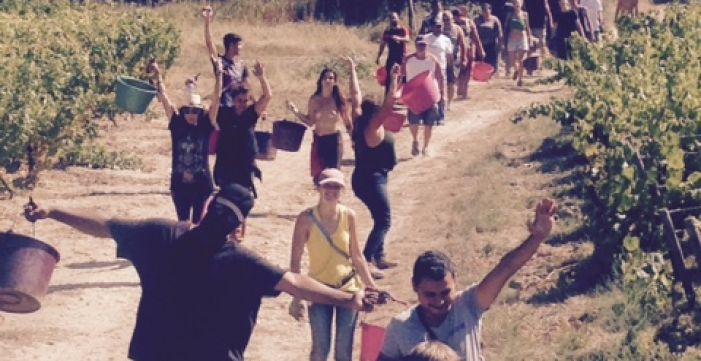
harvest report
14.11.2018
2018 Harvest Report from Domaine de la Pépière
<p><glossary title="521">Harvest</glossary> took place from September 3rd to the 21st under a warm sun and without a drop of rain. Another year of low <span class="zalup"><span> <glossary title="1129">yields</glossary><span>,</span></span></span> around 3 <span class="zalup"><span>0<glossary title="528">hl/ha</glossary><span>.</span></span></span> The alcoholic degrees were ideal in what we picked the first week, but quickly went up after that. We ended the <glossary title="521">harvest</glossary> in the Gras Moutons <glossary title="760">parcel</glossary> and the other <glossary title="1152">Crus</glossary> with potentials between 13 and 14,5!<br />
<br />
Fortunately the <glossary title="71">acidity</glossary> is still very present. This will help the wines, which will come from very <glossary term="Concentration" title="324">concentrated</glossary> grapes that are taking a long time to <span class="zalup"><span><glossary title="441">ferment</glossary><span>.</span></span></span></p>
<p><img src="http://louisdressner.com/uploads/images/article/2019_Sep_16//d8/4b/d84b469a70b4344e5c8f3b52fc897c9f.jpg" /></p>
<p><img src="http://louisdressner.com/uploads/images/article/2019_Sep_16//e5/d5/e5d5b5fd4f173694d5b622f34bc98b52.jpg" /></p>
<p><img src="http://louisdressner.com/uploads/images/article/2019_Sep_16//c2/61/c261dcd0d188c8928e73f0a35f8532f7.jpg" /></p>
Article

harvest report
10.10.2017
2017 Harvest Report from Rémi Branger
<p>We began picking on August 29th and finished on September 13th for the whites. Usually we are used to starting in mid-September, and the last time I can remember such a precocious <glossary title="521">harvest</glossary> was 2005. Here is a breakdown: Briords was <glossary title="521">harvested</glossary> August 30th,<strong> </strong>Château Thébaud on September 9th, Gras Mouton on September 6th and Clisson September 8th. Clisson we picked a little earlier than originally planned due to a rainy weekend forecast.<br />
<br />
A few days before <span class="zalup"><span><glossary title="521">harvest</glossary><span>,</span></span></span> we got 25mm of rain, which really helped advance <span class="zalup"><span><glossary title="639">maturities</glossary><span>.</span></span></span> It also ballooned the grapes a bit without diluting them. This is confirmed by the fact the juices are all between 11% and 12.5%, with five or six grams of <span class="zalup"><span><glossary title="71">acidity</glossary><span>.</span></span></span> Throughout <span class="zalup"><span><glossary title="521">harvest</glossary><span>,</span></span></span> the rain persisted and started degrading the grapes by the very end.<br />
<br />
Still, we are very satisfied with what we've brought into the <span class="zalup"><span><glossary title="254">cellar</glossary><span>:</span></span></span> a higher quantity than even a good year, and certainly more juice than we were estimating for the <span class="zalup"><span><glossary title="1109">vintage</glossary><span>.</span></span></span><br />
<br />
For the reds, the <glossary title="366">Côt</glossary> was <glossary title="521">harvested</glossary> on September 13th, the <glossary title="650">Merlot</glossary> on the 21st and the <glossary title="217">Cabernet</glossary> on the 26th. All of these were affected by <glossary title="1135">frost</glossary> and the <glossary title="639">maturities</glossary> are a little out of wack compared to a normal year.</p>
Article
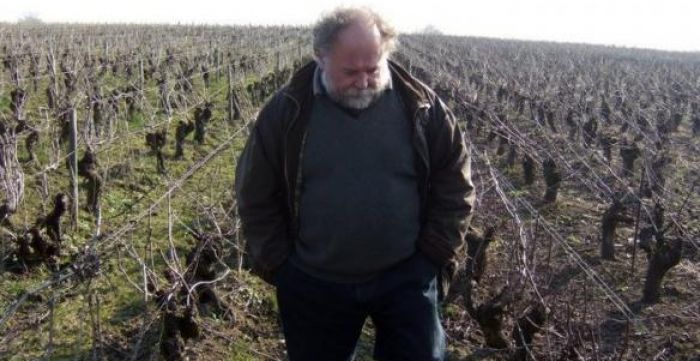
harvest report
20.09.2012
2012 Harvest Report from Marc Ollivier
<p><u><strong>September 20th, 2012:</strong></u></p>
<p>Some news from our <span class="zalup"><span><glossary title="521">harvest</glossary><span>,</span></span></span> which started yesterday. We began with a part of<font color="#7b143e"><strong> </strong></font>Clos des Briords with a bad surprise: <glossary title="1129">yields</glossary> are even lower than we expected. The good news is the quality of the <span class="zalup"><span><glossary title="700">must</glossary><span>:</span></span></span> 6.1 <glossary term="Acidity" title="71">acidity</glossary> and 12,5% <span class="zalup"><span><glossary term="alcoholic potential" title="1381">potential alcohol</glossary><span>!</span></span></span> This is the first time of my career that the qualitative potential has been so high on a first day of <span class="zalup"><span><glossary title="521">harvest</glossary><span>!</span></span></span><br />
<br />
A lot of <glossary title="1089">vignerons</glossary> think these <glossary title="71">acidities</glossary> are too high for the start of a <span class="zalup"><span><glossary title="521">harvest</glossary><span>,</span></span></span> but we think that with juice this dense, the balance is definitely going to be good and the <glossary title="71">acidity</glossary> will incorporate itself into the richness of the <span class="zalup"><span><glossary term="Must" title="700">must</glossary><span>.</span></span></span><br />
<br />
See you soon for more details.<br />
<br />
Marc.</p>
Article
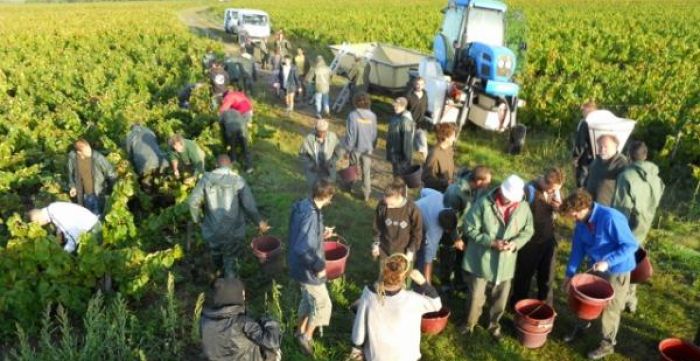
harvest report
09.08.2011
2011 Harvest Report from Eben Lillie
<p><u><strong>Part 1:</strong></u></p>
<p><u>Wednesday, August 31st:</u></p>
<p>Lots of rot (pourriture) in the vineyards, rain for three days last week has caused problems as the grapes <glossary term="Cluster/Bunch" title="1138">bunches</glossary> are consumed. Marc is worried about <glossary term="Yield" title="1129">yields</glossary> this year, as we were cutting off most of a <glossary term="Cluster/Bunch" title="1138">bunch</glossary> just to save 10 or 20 grapes out of what would normally be around 100. Luckily they have some new vineyards this year, one that is through the first year of <glossary term="Conversion" title="332">conversion</glossary> to <glossary term="Organic" title="746">organic</glossary> and has very good soil and a good slope facing the sun, which we were <glossary term="Harvest" title="521">harvesting</glossary> today, called Les Tigres. We will finish that <glossary term="Parcel" title="760">parcel</glossary> tomorrow and move on to the <glossary term="Young Vines" title="1130">young vines</glossary> at the Briords site. Marc says he can't remember a <glossary term="Vintage" title="1109">vintage</glossary> with this much rot in the vineyard since maybe 1994, and he simply can't remember a year with as much rain as they got in July and August. He's not happy but he says this year will really show the difference between <glossary term="Machine Harvesting" title="611">machine harvesting</glossary> and <span class="zalup"><span><glossary term="Hand Harvesting" title="520">hand harvesting</glossary><span>,</span></span></span> and will show that the hard work in the vineyard and the close attention to detail is very important. They are tasting the juice every day, multiple times a day, to see how it is evolving... With the <glossary term="Machine Harvesting" title="611">machine harvesting</glossary> in the area, they usually have to add lots of <span class="zalup"><span><glossary term="Sulfites" title="993">SO2</glossary><span>,</span></span></span> then also use coal to absorb flavor from the rotten grapes, then because that isn't enough, cream also, so they end up with a juice that is completely flat, devoid of flavor. and then they <span class="zalup"><span><glossary term="Inoculation" title="542">add the yeasts</glossary><span>.</span></span></span><br />
<br />
<u>Thursday, Sept 1st:</u><br />
<br />
Today I spent the morning with Remi, Marc's associate, and the afternoon <glossary term="Harvest" title="521">harvesting</glossary> in the vines. We took yesterday's <glossary term="Press Juice" title="1309">press juice</glossary> (the last, most concentrated juice of the pressing) for filtration, then returned in time to receive the grapes for the first crush of the day. ((Marc and Remi both feel it's important this year to have this pure clean juice (which tastes amazing and is really a dark orange in color) because it has so much flavor and will help to add richness back to the wine)) They're adding a very small amount of <glossary term="Sulfites" title="993">SO2</glossary> to the <glossary term="Cuve" title="365">cuve</glossary> this year, because of the rot that they are encountering. Usually it is 1 gram per <span class="zalup"><span><glossary term="Hectoliter" title="524">hectolitre</glossary><span>,</span></span></span> but it will probably end up being a few grams more this year depending on the significance of the rot. We measured the alcohol level, by measuring the sugar and then using a chart to determine the corresponding <span class="zalup"><span><glossary term="alcoholic potential" title="1381">potential alcohol level</glossary><span>,</span></span></span> which was a little low at 10.5 after the first two <span class="zalup"><span> <glossary term="Pressing" title="827">presses</glossary><span>,</span></span></span> and we measured the <span class="zalup"><span><glossary term="Acidity" title="71">acidity</glossary><span>,</span></span></span> which was ideal. I don't know what the numbers mean.. but it was 5.8 and somewhere between 5.5 and 5.8 is the aim, so 5.8 is ideal. Usually by the time the wine is <span class="zalup"><span><glossary term="Bottling" title="185">bottled</glossary><span>,</span></span></span> the level goes down a few points, so it would probably end up at 5.5. This still doesn't explain how much of this <glossary term="Acidity" title="71">acidity</glossary> is <span class="zalup"><span><glossary term="Malic Acid" title="1247">malo</glossary><span>,</span></span></span> <span class="zalup"><span><glossary term="Tartaric Acid" title="1012">tartric</glossary><span>,</span></span></span> citric, etc, but it gives a very good idea of what the end result will be. The <glossary term="Vat/Tank" title="1140">tank</glossary> with juice from the first two days (Monday and Tuesday, 8/29 and 8/30) of <glossary term="Harvest" title="521">harvest</glossary> has just started to <span class="zalup"><span><glossary term="Fermentation" title="441">ferment</glossary><span>,</span></span></span> with foam at the top of the tank. The juice is very tasty, with a little tingle of petillance from the gasses that are put out when the sugar converts to alcohol. Conditions were much better in the vines today. The vendangeurs (harvesters) were all at the original Pepiere site, which Marc has owned and tended for a long time. There was a lot less rot in the vineyards and we ended up doing four <glossary term="Pressing" title="827">presses</glossary> by the end of the day. The harvesters are a great bunch of people who are very fun to work with. I will write more about them and include pictures once I reveal to them that I am not just on a "stage" (like an internship) but that I'm also an "embedded reporter!" Today, Marc says he is happier with the <span class="zalup"><span><glossary term="Harvest" title="521">harvest</glossary><span>.</span></span></span> He noticed that at the edge of his vines, where his rows border his neighbors, there was a lot of rot, but in the middle, there were more healthy <glossary term="Cluster/Bunch" title="1138">bunches</glossary> and a lot less rot. His neighbor uses what Marc calls "food" and what I am quite positive is the French version of MiracleGro, which covers the surface of the vines. These particular vines have much more <glossary term="Foliage" title="1184">foliage</glossary> but the grapes are in worse condition. Marc also smelled <glossary term="Acetate" title="69">acetic acid</glossary> (which smells like vinegar and is very dangerous in winemaking) towards the end of the <glossary term="Harvest" title="521">harvest</glossary> today, and was careful to stop the harvesters in these sections. Apparently, if <glossary term="Acetate" title="69">acetic acid</glossary> gets into the juice, even at low levels, it can affect the entire <glossary term="Vat/Tank" title="1140">tank</glossary> and ruin the juice. I've been sampling some grapes here and there as I pick. The grapes are delicious. The plain old grape juice from the <glossary term="Pressing" title="827">press</glossary> today was so good, I temporarily regretted it was going to end up as wine... but then my common sense returned. Tomorrow we <glossary term="Harvest" title="521">harvest</glossary> Gras Moutons, which is a <glossary term="Parcel" title="760">parcel</glossary> that was given to Remi by his father, who has been making wine in <glossary term="Muscadet" title="697">Muscadet</glossary> for a long time. Marc is optimistic about the <span class="zalup"><span> <glossary term="Young Vines" title="1130">young vines</glossary><span>,</span></span></span> but has some worries about the <glossary term="Old Vines" title="740">old vines</glossary> at Gras Moutons, as they may have suffered from the unsavory weather conditions. On verra!</p>
<p><u><strong>Part 2:</strong></u></p>
<p>Today was a completely clear day, without any clouds. It was HOT! Every time I looked up and made eye contact with a fellow harvester the word that inevitably came out of both our mouths was "CHAUD!" I now have an official "winemaker's tan." My nose is almost as red as Marc's!<br />
<br />
The Gras Moutons site is really beautiful. It's situated on the top of a hill, with plenty of wind and even a view of <glossary term="Nantes" title="707">Nantes</glossary> in the far distance. There are <glossary term="Young Vines" title="1130">young</glossary> and <glossary term="Old Vines" title="740">old vines</glossary> here. In fact there are three different plantings. One that is about 15 years old, another around 30, and then the <glossary term="Old Vines" title="740">old vines</glossary> which are somewhere between 50 and 60 years old. Marc's predictions were right. The <glossary term="Old Vines" title="740">old vines</glossary> had more rot than the young. I asked him why and he mentioned how dense the leaves and the vines are. There were a lot of leaves on the <span class="zalup"><span><glossary term="Old Vines" title="740">old vines</glossary><span>.</span></span></span>.. easily the hardest vines to <glossary term="Harvest" title="521">harvest</glossary> so far, as the vines are so old and twisted and there are so many leaves in the way.<br />
<br />
The weekend is upon us. The harvesters get Saturday and Sunday off but there will be some work to do in the <span class="zalup"><span><glossary term="Cellar" title="254">cellar</glossary><span>,</span></span></span> obviously with today's juice, and in general preparation for next week. Just enjoyed a lovely outdoor dinner at Marc's home, and would have stayed outside all night if it wasn't for the "pique" from the mestique (mosquito).</p>
<p><img src="http://louisdressner.com/uploads/images/article/2019_Sep_25//1d/6c/1d6ca00f93cfb6ffe04a1a5bcecf4b27.jpg" /></p>
<p><img src="http://louisdressner.com/uploads/images/article/2019_Sep_25//8e/6f/8e6fc17b4d8cbbe6d2d81e94fe8dcaba.jpg" /></p>
<p><img src="http://louisdressner.com/uploads/images/article/2019_Sep_25//79/97/7997a36f1f01c9eb1c1b27f846703b68.jpg" /></p>
<p><img src="http://louisdressner.com/uploads/images/article/2019_Sep_25//01/7d/017d6b337db642fccba879b2c525b743.jpg" /></p>
<p><img src="http://louisdressner.com/uploads/images/article/2019_Sep_25//a9/a3/a9a3eef06f42e3ef59857d2efcf41e3e.jpg" /></p>
<p><img src="http://louisdressner.com/uploads/images/article/2019_Sep_25//5a/a0/5aa0fbb80438bfb8144370bd7d218260.jpg" /></p>
<p><img src="http://louisdressner.com/uploads/images/article/2019_Sep_25//d1/09/d10960028daf6dc54e8cc6957b8ff753.jpg" /></p>
<p><img src="http://louisdressner.com/uploads/images/article/2019_Sep_25//88/ee/88eea84cbdec01a1b111540811953be5.jpg" /></p>
<p><img src="http://louisdressner.com/uploads/images/article/2019_Sep_25//f2/7e/f27e54a4fbe593a927b65e951c42944a.jpg" /></p>
<p><img src="http://louisdressner.com/uploads/images/article/2019_Sep_25//c9/0e/c90e2106772869f34cc96724d359e96c.jpg" /></p>
<p><img src="http://louisdressner.com/uploads/images/article/2019_Sep_25//5d/22/5d22c0b17343000dd50213ef4972ba5d.jpg" /></p>
<p><img src="http://louisdressner.com/uploads/images/article/2019_Sep_25//a2/74/a2741612749c21962957f7e28443db73.jpg" /></p>
<p><img src="http://louisdressner.com/uploads/images/article/2019_Sep_25//70/85/7085ba098827b9a2a123e15647018f82.jpg" /></p>
<p><img src="http://louisdressner.com/uploads/images/article/2019_Sep_25//56/62/5662dc5dcb9d832caa4fef9467e401e6.jpg" /></p>
<p><img src="http://louisdressner.com/uploads/images/article/2019_Sep_25//6d/bd/6dbd6057438112d5e29bca98e39cddc1.jpg" /></p>
<p><img src="http://louisdressner.com/uploads/images/article/2019_Sep_25//5f/36/5f36be74ff320914f78bf718094b1e03.jpg" /></p>
<p><img src="http://louisdressner.com/uploads/images/article/2019_Sep_25//d6/20/d620126e9e7855c7e9a3e2497bbb0b49.jpg" /></p>
<p><img src="http://louisdressner.com/uploads/images/article/2019_Sep_25//03/17/031786a31d36dcf0242c38b865264e13.jpg" /></p>
<p><img src="http://louisdressner.com/uploads/images/article/2019_Sep_25//4a/fd/4afd22f19a501192ab2ffe8f8a2b2175.jpg" /></p>
<p><img src="http://louisdressner.com/uploads/images/article/2019_Sep_25//b0/e9/b0e95b9f05901b09c1237102bf617047.jpg" /></p>
<p><img src="http://louisdressner.com/uploads/images/article/2019_Sep_25//b2/e1/b2e16166c236d01ec2a971b56139c015.jpg" /></p>
<p><img src="http://louisdressner.com/uploads/images/article/2019_Sep_25//a4/56/a4565da909ccdad87a907cf2ba8022b3.jpg" /></p>
<p> </p>
Article
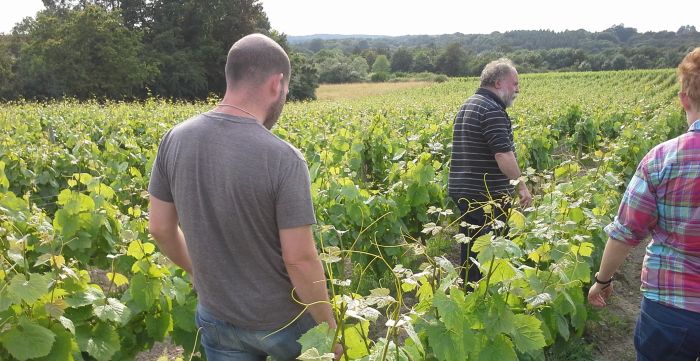
harvest report
05.09.2011
2011 Harvest Report from Marc Ollivier
<p><u><strong>September 5th, 2011:</strong></u></p>
<p>Because of heavy rainfall, 10 to 30% of our grapes this year are rotten. We've been <glossary term="Sorting" title="1380">sorting</glossary> through <span class="zalup"><span><glossary title="1138">bunches</glossary><span>,</span></span></span> and have been forced to throw away some usuable grapes because large parts of those <glossary title="1138">clusters</glossary> were too affected by rot.<br />
<br />
The <glossary title="1129">yields</glossary> for the first week were 35 <span class="zalup"><span><glossary title="528">hl/ha</glossary><span>.</span></span></span> Hopefully we'll get bigger numbers in the following days!<br />
<br />
The good news is in the quality of the juice; the years of sorting experience I've instilled in my harvesters has really paid off. It's been more time consuming than I expected, but the effort was well worth it; the juice is clear, with great <glossary title="71">acidity</glossary> (5.8 g/l) and the sugar levels are just where I want them to be. The first batch was at 10.5 and we've now reached 11%.<br />
<br />
We'll be <glossary title="521">harvesting</glossary> the <glossary title="740">old vines</glossary> at Briords on Tuesday. We just finished Gras Moutons; less rot and the grapes were very ripe. The Pépière vines are in good shape too, although we've only been there one day so far. It looks like only the Briords were a real problem, and we probably will have very little to <glossary title="185">bottle</glossary> this year.</p>
Article
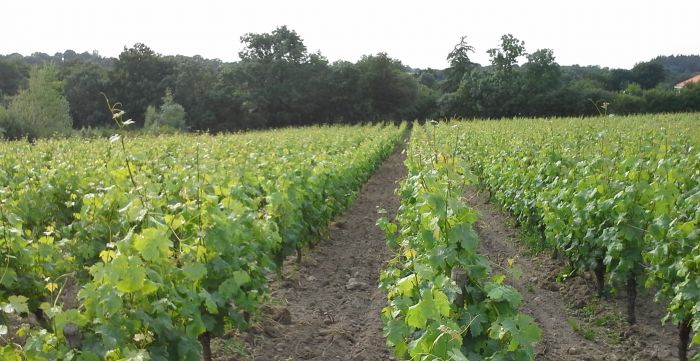
harvest report
19.09.2010
2010 Harvest Report from Marc Ollivier
<p><u><strong>Part 1, September 19th 2010:</strong></u></p>
<p>It has already been a week since the picking started; the weather has been magnificent, a continuation of this very dry summer.<br />
<br />
Luckily, we got 15mm of rain the week before the <span class="zalup"><span><glossary title="521">harvest</glossary><span>.</span></span></span><br />
<br />
Right now, the <glossary title="700">musts</glossary> in the <glossary title="254">cellar</glossary> are fabulous, the only minor negative being that the <glossary title="71">acidity</glossary> in certain<strong> <glossary title="365">cuves</glossary></strong> is a little low for my taste.<br />
<br />
The sugar levels are slightly higher than last year; the average for last week’s <glossary title="521">harvest</glossary> at 11.5.<br />
<br />
The <glossary title="1129">yields</glossary> are pretty small, around 45 <glossary title="528">hl/ha</glossary>; this due to both the lack of rain this summer and a <glossary title="507">green harvest</glossary> done in July.<br />
<br />
We have already picked half of the grapes of the 7.5 <span class="zalup"><span> <glossary title="523">ha</glossary><span>,</span></span></span> including most of the Pépière <span class="zalup"><span> <glossary title="363">cuvées</glossary><span>,</span></span></span> the<strong> </strong>Clos des Briords and the Granite de<strong> </strong>Château Thébaud which leaves for this week, the last Pépière <glossary title="1133">plots</glossary> above the village, les Gras Moutons and the Clisson.<br />
<br />
Forecasts predict rain, especially for Thursday, Sept. 23rd. Between now and then, we should be able to get almost everything in out of harm’s way because due to the <glossary title="71">acidity</glossary> levels, I have a really big team of pickers this year (45 people). This is the big difference between 2009 and 2010. In 2009, we were able to stretch out the <glossary title="521">harvest</glossary> over three weeks and still the last <glossary title="700">musts</glossary> had around 5g/l of <span class="zalup"><span><glossary title="71">acidity</glossary><span>.</span></span></span> In 2010, the first juice we brought into the <glossary title="254">cellar</glossary> had the same 5g/l.<br />
<br />
Therefore the need to <glossary title="521">harvest</glossary> very quickly. Ideally, we would have already been finished but for some obscure reasons the official start of <glossary title="521">harvesting</glossary> began on September 9th. To compare this year with previous years, normally I would have started <glossary title="521">harvesting</glossary> on the 16th or 17th (always at least a week after the official start) . The result was that some of the earliest ripening areas were <glossary title="521">harvested</glossary> with less than 4g/l of <span class="zalup"><span><glossary title="71">acidity</glossary><span>.</span></span></span> With this sort of balance, <glossary title="697">Muscadet</glossary> loses an important part of its essential identity. It’s almost as if there were a conspiracy on the part of the local growers union and the national agencies in charge of wine to push the evolution of the <glossary title="697">Muscadet</glossary> towards a pale copy of the southern model.<br />
<br />
Lastly I would add that these two <glossary title="1109">vintages</glossary> (2009 & 2010) seem to me to be almost exact copies of 1989 and 1990, and this bodes very well for the development of the 2010 <span class="zalup"><span><glossary title="1109">vintage</glossary><span>.</span></span></span></p>
<p><u><strong>Part 2, October 13th 2010:</strong></u></p>
<p>Our second week of picking, from Sept. 20th to 25th, went under a resplendescent sun. We harvested the last <glossary title="1133">plots</glossary> of la Pépière, Granite de Clisson and Gras Moutons. The berries got <glossary title="324">concentrated</glossary> and sugar levels climbed up, all <glossary title="700">musts</glossary> that week reached a <glossary title="87">potential</glossary> 12.4 to 13.2% alcohol! Because of the <glossary title="324">concentration</glossary> factor, <glossary title="71">acidity</glossary> levels stayed stable or even increased, between 4.8 and 5.2g/l.<br />
<br />
On Friday Sept. 24th, after some tests, we picked our <glossary title="366">Côt</glossary> and <span class="zalup"><span><glossary title="650">Merlot</glossary><span>,</span></span></span> all very ripe, 12.6% for <glossary title="366">Côt</glossary> and almost 14% for <span class="zalup"><span><glossary title="650">Merlot</glossary><span>.</span></span></span> I had decided to wait for the <span class="zalup"><span><glossary title="216">Cabernets</glossary><span>,</span></span></span> which <glossary title="639">mature</glossary> last, but a lot of rain between Oct. 1st and 5th ruined the party. So we picked them on Oct. 6th and 8th, still wet from the rain, with the skins beginning to crack: what my colleagues did not <glossary title="521">harvest</glossary> before today all went to rot.<br />
<br />
I hope that <glossary title="105">Anjou</glossary> and <glossary title="1036">Touraine</glossary> did not get as much water as we did!<br />
<br />
<glossary title="441">Fermentations</glossary> are going without trouble, the first vats to be picked are almost done; the first Pépière batches are very pleasant to taste. On the other hand, Briords and Granite of Château Thébaud are tight and very hard to taste now.</p>
Article
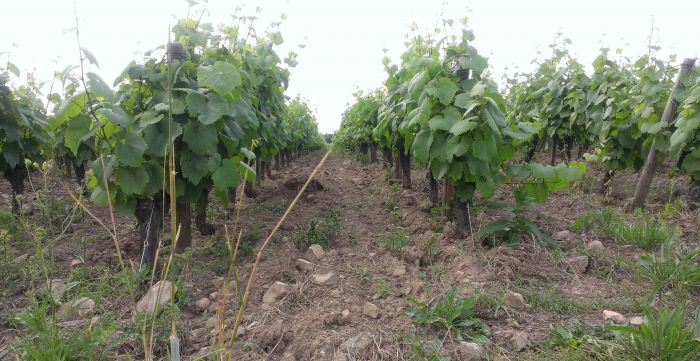
harvest report
06.10.2009
2009 Harvest Report from Marc Ollivier
<p><u><strong>October 6th, 2009:</strong></u></p>
<p>[Written early September, before the <span class="zalup"><span><glossary title="521">harvest</glossary><span>:</span></span></span>]<br />
<br />
There is real <glossary title="1167">drought</glossary> here: it rained 30mm in June, 30mm in July, nothing in August. The fields are burnt, trees like oak and ash are dying, the only green left is the vines. Even if some <glossary title="1133">plots</glossary> are really suffering from the lack of water, on the whole the grapes are superb, with already good ripeness and high <span class="zalup"><span><glossary title="71">acidity</glossary><span>.</span></span></span><br />
<br />
[During the <glossary title="521">harvest</glossary>]</p>
<p>We started our <glossary title="521">harvest</glossary> on Sept. 16th, and that first week it rained on Thursday. We were able to pick several <glossary title="1140">vats</glossary> of Pépière at good <span class="zalup"><span><glossary title="639">maturity</glossary><span>,</span></span></span> around 11 degrees and 5.5g. of <span class="zalup"><span><glossary title="71">acidity</glossary><span>.</span></span></span><br />
<br />
Our second week was spent under sunny skies, and it got pretty hot. We <glossary title="521">harvested</glossary> the<b> </b>Clos des Briords at 11.7 degrees and 5g of <span class="zalup"><span> <glossary title="71">acidity</glossary><span>.</span></span></span> We also picked our new village <glossary title="113">appellation</glossary> vines in<font color="#7b143e"><strong> </strong></font>Château Thébaud, and the figures were similar.<br />
<br />
The sun was still shining the third week, and the grapes ripened further. On Tuesday, we picked the Gras Moutons <span class="zalup"><span><glossary term="Plot" title="1133">plot</glossary><span>:</span></span></span> the crop was superb, <glossary term="alcoholic potential" title="1381">potential degree</glossary> also with 12.1 and 4.8g <span class="zalup"><span><glossary title="71">acidity</glossary><span>.</span></span></span> On Thursday and Friday October 1st and 2nd, we picked the grapes meant for Granite de Clisson: wonderful <span class="zalup"><span><glossary title="1138">bunches</glossary><span>,</span></span></span> low <glossary title="1129">yield</glossary> (some <glossary title="181">botritys</glossary> from the September rain.) With 13 degrees and 4.7g <span class="zalup"><span><glossary title="71">acidity</glossary><span>,</span></span></span> I hope this <glossary title="363">cuvée</glossary> is going to find its balance. I don’t have much experience with making such high degree wines, but I am hopeful since the <glossary title="71">acidity</glossary> level is good.<br />
<br />
This is really a generous <span class="zalup"><span><glossary title="1109">vintage</glossary><span>,</span></span></span> high quality AND good volumes. After two rather difficult years, at last we have a great crop!<br />
<br />
The reds are not all in yet, I have picked my <span class="zalup"><span><glossary title="366">Côts</glossary><span>,</span></span></span> sensational, and some <glossary title="650">Merlot</glossary> for<font color="#7b143e"><strong> "</strong></font>Cuvée Granite". <glossary title="217">Cabernets</glossary> are to be done next week.</p>
Article
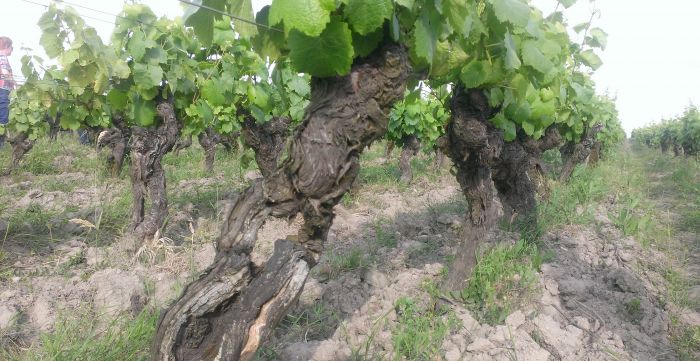
harvest report
08.09.2007
2007 Harvest Report from Marc Ollivier
<p><u><strong>September 8th, 2007:</strong></u></p>
<p>The <glossary title="521">harvest</glossary> hasn’t started yet! We will start on 9/14, and right now the weather is wonderful: cool nights (about 50 degrees early morning), sunny and warm days with eastern wind (around 75-78 today Saturday.) So every condition is right to keep the grapes healthy and <glossary term="Concentration" title="324">concentrate</glossary> them. I do not have any rot to worry about.<br />
<br />
The only minus for me is that my <span class="zalup"><span><glossary title="746">organically</glossary><span>-</span></span></span>farmed vines are ripening even later. They were 12 days behind a week ago, and now I’d say only 8 or 9 days. I think the <glossary title="639">maturation</glossary> was blocked by the <glossary title="333">copper</glossary> I had to use early August.</p>
<p>All points to ideal weather conditions, which, we hope, will last till the end of September.<br />
<br />
<glossary title="71">Acidity</glossary> levels are still very high, around 7/8 grams/liter, and <glossary term="alcoholic potential" title="1381">potential alcohol degrees</glossary> of 9.5. My hope is to get around 6 grams/liter and 11 degrees when we start picking.</p>
Article

harvest report
24.09.2006
2006 Harvest Report from Marc Ollivier
<p><u><strong>September 24th, 2006:</strong></u></p>
<p>2006, year of the fungus! I have just spent an hour picking the many mushrooms that grow everywhere in the fields, and here’s my conclusion: mushrooms in the fields and fungi on the grapes….<br />
<br />
We had <glossary title="1137">mildew</glossary> and <glossary title="737">black rot</glossary> threats this summer, and <glossary title="182">grey rot</glossary> started at the end of August. And so much rain all through the summer: 60mm in July, 70mm in August, and already 100mm in September! No surprise that rot was so prevalent, given that rain was often in conjunction with high temperatures.<br />
<br />
We picked our <glossary title="697">Muscadet</glossary> from Monday Sept. 11th to Saturday Sept. 23rd. From the first days, we had to <glossary title="1380">sort</glossary> grapes carefully. We had to throw out about 10% of the grapes, up to 50% in one <glossary title="1133">plot</glossary> on Sept. 22nd. So we have a small crop (45<glossary title="528">HL/HA</glossary>) and it has been hard work picking and <span class="zalup"><span><glossary title="1380">sorting</glossary><span>,</span></span></span> often under the rain.<br />
<br />
Nevertheless, the results are satisfying. My 11 <glossary title="1140">vats</glossary> go from 11 to 11.7 of natural degrees, and from 4.7 to 5.1 gram/liter of <glossary title="71">acidity</glossary> (most <glossary title="700">musts</glossary> are at 4.7 or 4.8 g/l in <glossary title="71">acidity</glossary>). The <glossary title="441">fermenting</glossary> wines are very pleasant to taste, very clean and frank (this won’t be the case everywhere in the region.)<br />
<br />
About 80% of the <glossary title="700">musts</glossary> <glossary title="611">harvested by machine</glossary> had to be treated to eliminate the smell and taste of rot: this entailed a passage through charcoal, a passage through fresh cream and a <span class="zalup"><span><glossary title="449">fining</glossary><span>.</span></span></span> I myself had to do all this because I <glossary title="521">harvested</glossary> one <glossary title="1133">plot</glossary> by <glossary title="611">machine</glossary> for wine I sell to a <span class="zalup"><span><glossary title="252">coop</glossary><span>:</span></span></span> there isn’t much wine left behind these treatments.<br />
<br />
So, a very difficult <span class="zalup"><span><glossary title="521">harvest</glossary><span>,</span></span></span> and very expensive, but I am very happy with the quality of the future <glossary title="697">Muscadets</glossary> from La Pépière. It comforts me in the notion that the only way to pick is by <span class="zalup"><span><glossary title="520">hand</glossary><span>,</span></span></span> especially in difficult years.<br />
<br />
There is great homogeneity over all the <span class="zalup"><span><glossary title="1140">vats</glossary><span>,</span></span></span> and I am surprised by the lack of difference in ripeness and <glossary title="71">acidity</glossary> between the <glossary title="740">old vines</glossary> and the <span class="zalup"><span><glossary title="1130">younger ones</glossary><span>.</span></span></span> I think <glossary title="662">minerality</glossary> will make the difference later.<br />
<br />
I think I am going to pick my red grapes without delay. I have surveyed my vines and there is rot on some berries.</p>
Article
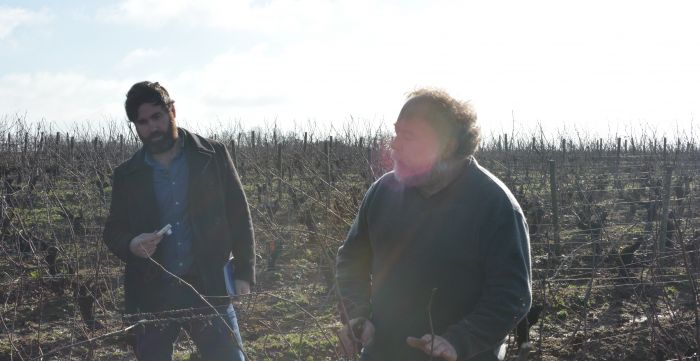
harvest report
03.10.2005
2005 Harvest Report from Marc Ollivier
<p><u><strong>Part 1, September 11th, 2005: </strong></u></p>
<p>Some news from<font color="#7b143e"><strong> Domaine</strong></font> de la Pépière: The <glossary title="521">harvest</glossary> started on Wednesday, September 7th; it was so hot we could barely stand it. A this point, we have <glossary title="521">harvested</glossary> three <glossary title="1140">vats</glossary> of Pépière. It’s looking really good with 11.3 degrees of <glossary term="alcoholic potential" title="1381">potential alcohol</glossary> and 4.8 grams of <span class="zalup"><span><glossary title="71">acidity</glossary><span>,</span></span></span> in other words, the same as last year. Today, Monday, we are picking the<font color="#7b143e"><strong> </strong></font>Clos des Briords.</p>
<p><u><strong>Part 2, September 18th, 2005: </strong></u></p>
<p>The past week has been really beautiful with just a few drops of rain on Friday.<br />
<br />
The Clos des Briords, <glossary term="Harvest" title="521">harvested</glossary> on Monday, had 11.9 degrees of <glossary term="alcoholic potential" title="1381">potential alcohol</glossary> and 4.8 grams of <glossary term="Acidity" title="71">acidity</glossary> (a little less than 2004).<br />
<br />
The "Cuvée Eden", <glossary term="Harvest" title="521">harvested</glossary> on Tuesday had 11.9 degrees of <glossary term="alcoholic potential" title="1381">potential alcohol</glossary> and 4.45 grams of <glossary term="Acidity" title="71">acidity</glossary> and like the Clos des Briords just a tiny bit inferior to the 2004.<br />
<br />
On the other hand, the Moulin de la Gustaie, at 11.5 degrees of the <glossary term="alcoholic potential" title="1381">potential alcohol</glossary> and 4.6 grams of <span class="zalup"><span><glossary term="Acidity" title="71">acidity</glossary><span>,</span></span></span> is actually better than in 2004.<br />
<br />
On Thursday and Friday, we picked two more <glossary term="Vat/Tank" title="1140">vats</glossary> of Pépière. This second batch is clearly better than the two vats we <glossary term="Harvest" title="521">harvested</glossary> last Thursday and Friday. That is, they were at 11.6 degrees of <glossary term="alcoholic potential" title="1381">potential alcohol</glossary> and 4.6 grams of <glossary term="Acidity" title="71">acidity</glossary> and 12.3 degrees of <glossary term="alcoholic potential" title="1381">potential alcohol</glossary> and 4.3 grams of <span class="zalup"><span><glossary term="Acidity" title="71">acidity</glossary><span>.</span></span></span><br />
<br />
What’s left are the <glossary term="Old Vines" title="740">old vines</glossary> of Pépière. It should go well: it looks like the weather will be good.<br />
<br />
On average, both the degrees of potential alcohol and the <glossary term="Acidity" title="71">acidity</glossary> levels are about 0.3 points below 2004.</p>
Article
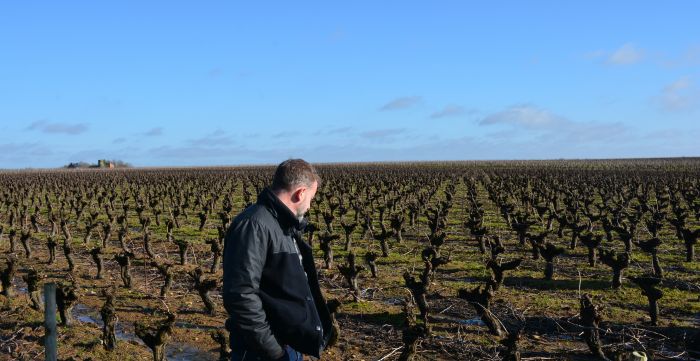
harvest report
21.09.2004
2004 Harvest Report from Marc Ollivier
<p><u><strong>September 21st, 2004:</strong></u></p>
<p>The 2004 <glossary title="521">harvest</glossary> commenced after 15 days of pure sunshine. This had come unexpected as the summer had confirmed itself as rainy. We began <glossary title="521">harvesting</glossary> Wednesday, September 15th and picked the first part of the<font color="#7b143e"><strong> </strong></font>Domaine de la Pépière. Despite some slightly large <glossary title="1129">yields</glossary> from these <span class="zalup"><span> <glossary title="1130">young vines</glossary><span>,</span></span></span> the grapes showed up an interesting proportion of sugar. Here below are the natural degrees of the different <glossary title="363">cuvées</glossary> <span class="zalup"><span><glossary title="521">harvested</glossary><span>.</span></span></span><br />
<br />
1st part of La Pépière: 11 degrees, <glossary title="71">acidity</glossary> 4.8 grams<br />
<br />
1st part of Briords: 11.6 degrees, <glossary title="71">acidity</glossary> 5.1 grams<br />
<br />
1st part of Eden: 12 degrees, <glossary title="71">acidity</glossary> 4.8 grams<br />
<br />
This is all very encouraging for what is to follow. The weather for the next week should be very mild with sunshine. The wine will be, at their natural degrees, identical to last year but with more <span class="zalup"><span><glossary title="71">acidity</glossary><span>.</span></span></span> The overall balance will certainly be better.</p>
Article
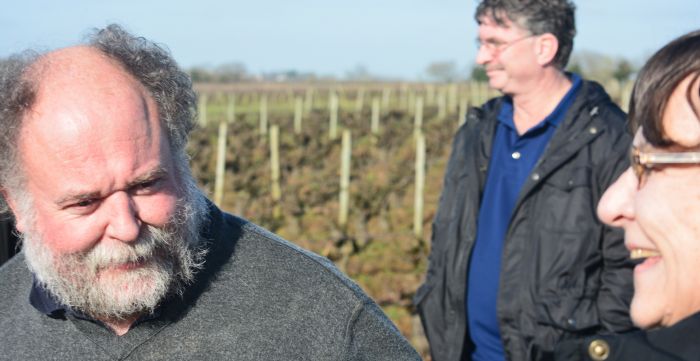
harvest report
01.09.2003
2003 Harvest Report from Marc Ollivier
<p><u><strong>Part 1, September 1st, 2003:</strong></u></p>
<p>The <glossary title="521">harvest</glossary> started on August 26th with the younger vines of Domaine de la Pépière:<br />
<br />
Average <glossary title="1381">potential alcohol</glossary> : 11% - <glossary title="71">Acidity</glossary> 4.5 grams/liter.<br />
<br />
<glossary title="71">Acidity</glossary> levels are very low (30% lower than last year). The sun and excessive heat have broken down the <glossary title="1247">malic acid</glossary> which should result in the wine being very round and pleasant. On the other hand, the <glossary title="74">aging</glossary> potential of these wines is questionable.<br />
<br />
We started <glossary title="521">harvesting</glossary> the<b> </b>Clos des Briords (at 11.7% <glossary title="1381">potential alcohol</glossary> and 5 grams/liter <glossary title="71">acidity</glossary>) but had to stop on Friday morning. A violent storm beat down on the vineyard with <glossary title="1136">hail</glossary> hitting certains areas - among others the vines that produce<strong> "</strong>Cuvée Eden". At that point it became absolutely necessary to focus our efforts on picking these mildly damaged - but still good quality grapes (11.8% <glossary title="1381">potential alcohol</glossary>/ 4.5 grams/liter <glossary title="">acidity</glossary>) -as soon as possible. The<strong> "</strong>Cuvée Eden" grapes were picked on Friday, August 29 and Saturday, August 30. By today, Monday, September 1 all the grapes that remained on the vines are virtually ruined.<br />
<br />
<glossary title="521">Harvesting</glossary> will continue this week with the Clos Cormerais, the second part of the<strong> </strong>Clos des Briords and the older<strong> </strong>Domaine de la Pépière vines.</p>
<p><u><strong>Part 2, September 6th, 2003:</strong></u></p>
<p>Voilà, the <glossary title="521">harvesting</glossary> is finished. The grapes were picked in record time and, in spite of a violent storm with <glossary title="1136">hail</glossary> one night, we had warm, dry weather every day. Here is a quick summary of the different <span class="zalup"><span><glossary title="363">cuvées</glossary><span>:</span></span></span></p>
<p>Domaine de la Pépière (<glossary title="1130">younger vines</glossary>) – Harvested on August 26th, 27th, 28th. Average degree of <span class="zalup"><span><glossary title="1381">potential alcohol</glossary><span>:</span></span></span> 11% <glossary title="71">Acidity</glossary> 4.6 grams/liter.<br />
<br />
Clos des Briords – <glossary title="521">Harvested</glossary> on August 29th and September 3rd.<br />
12% <glossary title="1381">potential alcohol</glossary> <glossary title="71">Acidity</glossary> 5 grams/liter.<br />
<br />
Cuvée Eden – <glossary title="521">Harvested</glossary> on August 29th and 30th<br />
11.9% <glossary title="1381">potential alcohol</glossary> <glossary title="71">Acidity</glossary> 4.5 grams/liter<br />
<br />
Clos Comerais – <glossary title="521">Harvested</glossary> on September 1st<br />
12% <glossary title="1381">potential alcohol</glossary> <glossary title="71">Acidity</glossary> 4.4 grams/liter<br />
<br />
Domaine de la Pépière (<glossary title="740">old vines</glossary>) – <glossary title="521">Harvested</glossary> on September 2nd and 3rd. 12.2% <glossary title="1381">potential alcohol</glossary> <glossary title="71">Acidity</glossary> 4.4 grams/liter<br />
<br />
The <glossary title="71">acidity</glossary> levels are on the low side, but adequate. A later <glossary title="521">harvest</glossary> would have allowed us to pick grapes with record levels of <span class="zalup"><span><glossary title="1381">potential alcohol</glossary><span>.</span></span></span> Right now, some grapes are at 13.2% with only 3.1 grams/liter <span class="zalup"><span><glossary title="71">acidity</glossary><span>.</span></span></span> These wines will require the addition of some <span class="zalup"><span><glossary title="1012">tartaric acid</glossary><span>.</span></span></span> The choice we made at Domaine de la Pépière will allow us to vinify virtually all the <glossary title="521">harvest</glossary> with neither <glossary title="270">chaptalisation</glossary> nor <span class="zalup"><span><glossary title="70">reacidification</glossary><span>.</span></span></span><br />
<br />
The <glossary title="441">fermentations</glossary> are developing normally with a few <glossary title="1140">vats</glossary> taking their time getting started.<br />
<br />
In sum, everything looks good so far and I hope that this <glossary title="1109">vintage</glossary> lives up to the reputation that it already has!</p>
Article

































